












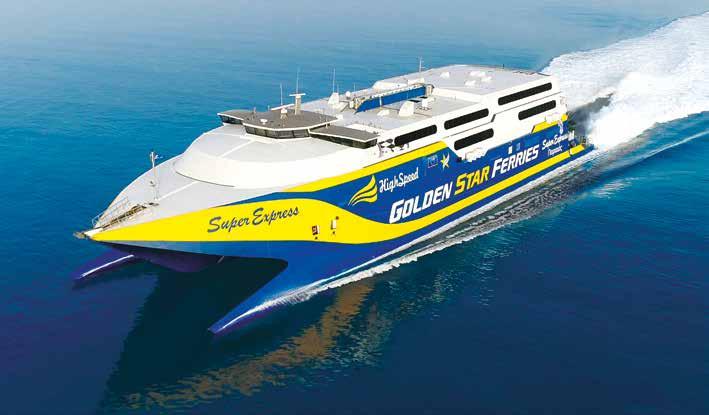
Ever since we returned from last year’s holiday, we haven’t stopped thinking about this year’s destination. And finally, it’s time again to leave daily life, problems and worries behind and set sail for our favourite Cycladic destination.
Cosmopolitan Mykonos, unique Santorini, green Andros, alternative Ios, adventurous Paros and multifaceted Tinos are not just random attractions for visitors from all over the world -their special beauty, diverse activities, vibrant nightlife, stunning beaches and rich culinary scene are bound to leave a lasting impression on everyone.
That’s why we set sail for there. Together. With Golden Star Ferries’s stateof-the-art, reliable ships, which are built to take you safely and comfortably to your favourite summer destination in the Cyclades. No matter which vessel you choose -the majestic Andros Queen, the luxurious Superferry or the fast Superexpress- you can rest assured that you’ll have everything you need to make your trip memorable.
Besides, since 2011, Golden Star Ferries has aimed to turn every trip into a real hospitality experience by offering high-quality transportation services. The experienced crews of its ships are always on hand to ensure your journey is comfortable and carefree, providing a professional and friendly service. Travelling is more than just getting to your destination; it’s the first step of your holiday, the first step towards the unique experiences that await you this summer.
An impeccable experience of travelling by sea and an amazing destination. What else do you need for your journey to be truly memorable? The right
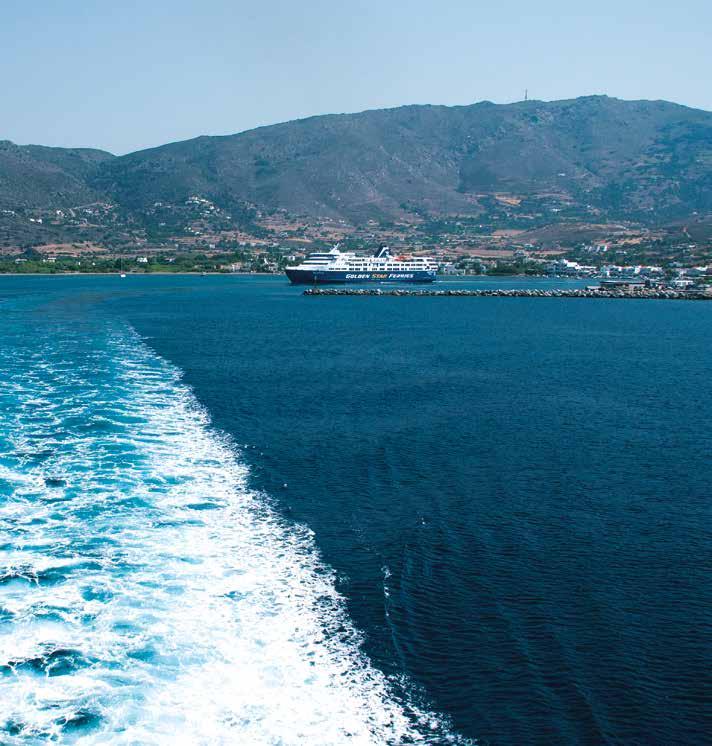
companion, of course! Golden Stars -the magazine you’re holding that will accompany you on your holiday this year. The following pages contain information to help you get to know the destinations, their people, events, culture and gastronomy, as well as featuring interesting interviews with celebrities and prominent figures. It offers a glimpse of what awaits you on the island, and is further proof of Golden Star Ferries’s commitment to providing unique services and benefits to its passengers.
We hope you have a pleasant journey and enjoy a summer full of sunshine, swimming and unforgettable experiences.









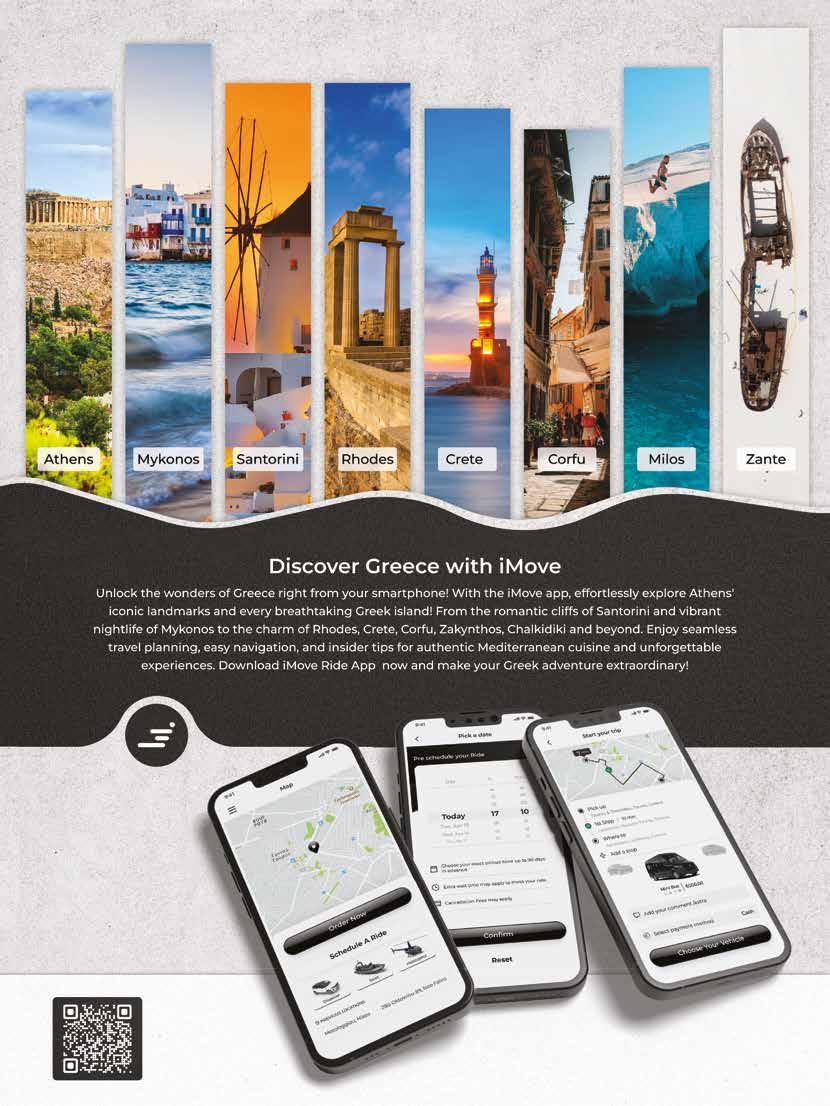

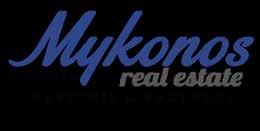



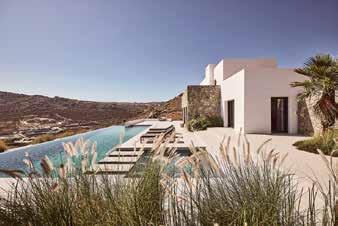





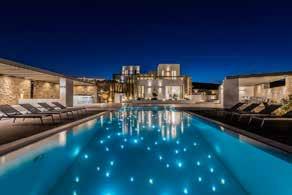

Offices:
Athens: 13-15 Sofokleous Rd, Athens
w w w . r e v i t h i s - r e a l e s t a t e . c o m
D r o s i a : 2 M a r a t h o n o s S t r .
w w w . r e v i t h i s . c o m
Mykonos: New Region Drafaki Rd, (Above Piraeus Bank)
w w w m y k o n o s - r e a l e s t a t e c o m
Arachova: Old Nation Rd
www.parnassos-realestate.com
Vouliagmeni: Astir Marina Vouliagmenis, South Suburbs
w w w . g r e e k t o p v i l l a s . c o m r e a l e








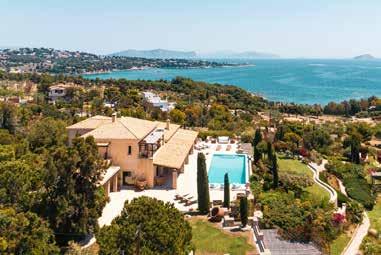
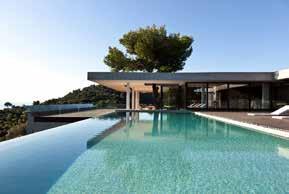

PMS MEDIA
18o χλμ.
Creative
Golden Star Ferries Shipping Company
Φίλωνος 133, Πειραιάς Τηλ.: 212 2224000, www.goldenstarferries.gr
Production – Publishing PMS MEDIA
18th km Marathonos ave. & Pilou str., 153 51 Pallini
Τel.: +30 210 3212 037 info@pmsmedia.gr
Managing Director: Xanthi Iliopoulou
Managing Editor: Thanassis Toloudis
Creative Director: Nikos Vatsitsis
Art Director: Alexandros Bitsaras
Contributors: Maria Atmatzidou, Mia Kollia, Asteropi Lazaridou
Copy Editor: Niki Stathia
Translation: Evita Lykou
Photos: Andreas Simopoulos
Commercial Director: Stavros Kefalopoulos
Advertising Managers: Giorgos Andreadelis, Lena Konitsa, Kaiti Konitsa, Marifili Papanikolaou, Stella Selianiti, Peggy Stebili
Printing: PaperGraph S.A.
Your Free Copy
It is illegal to publish, reproduce, or transmit in whole or part of the magazine without the written permission of the publisher. The GOLDEN STAR FERRIES isn’t responsible for the contributors’ opinions as they are represented on issues.
Golden Star Ferries Shipping Company
133, Filonos Str., Piraeus Τel.: +30 212 2224000, www.goldenstarferries.gr


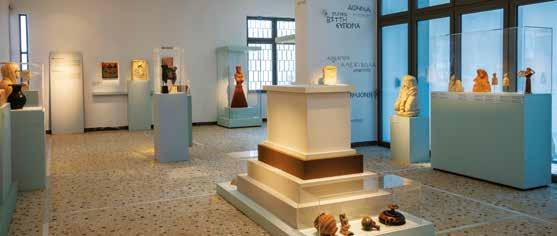



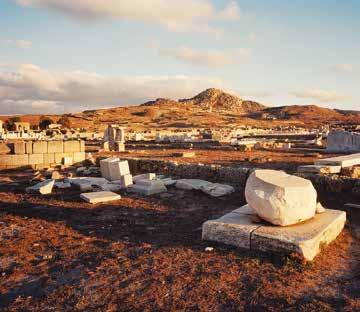



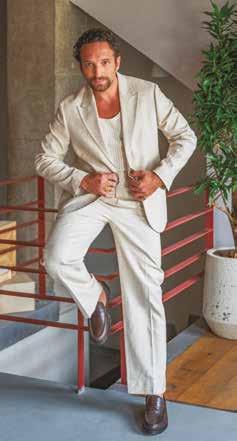
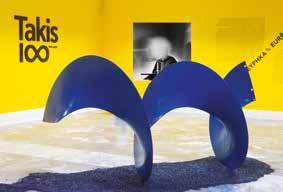
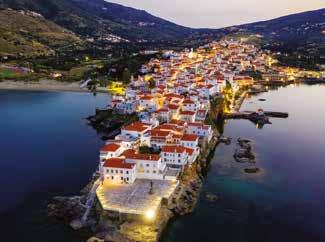

Five
Another

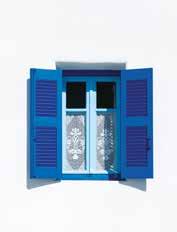
ΕΡΕΘΙΣΜΕΝΟΣ


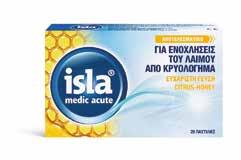



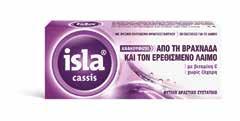

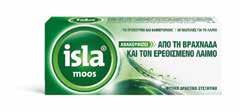
THE RENOVATED ARCHAEOLOGICAL MUSEUM OF THERA CELEBRATES ITS REOPENING WITH THE IMPRESSIVE “KYKLADITISSES: UNTOLD STORIES OF WOMEN IN THE CYCLADES” EXHIBITION, FEATURING THE KORE OF THERA, WHICH NOW HAS A PERMANENT HOME IN THE MUSEUM. THE DIRECTOR OF THE EPHORATE OF ANTIQUITIES OF CYCLADES DR DEMETRIOS ATHANASOULIS TELLS US MORE.

TThe first building was constructed in 1902 to house artefacts from ancient Thera, which were discovered by the German Archaeological Institute in the late 19th century. The museum was built because the finds were so impressive that they needed to be immediately protected, and, of course, so that people could see them. The building collapsed in the 1956 earthquake. As part of Santorini’s reconstruction, a new museum was built in a different location next to the current cable car station. This building was designed by Konstantinos Dekavallas”, says Dr Demetrios Athanasoulis, Director of the Ephorate of Antiquities of the Cyclades. Despite his busy schedule, he found time to talk to us about this place that he particularly loves.
“It is an interesting architectural project based on modernist principles that takes into account its location in the Caldera. The architect designed
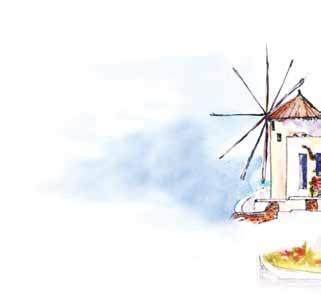


a structure that develops around a central atrium, giving it a coherent internal layout. At the same time, however, he also created visual outlets so that one can perceive the external landscape of Santorini from inside the museum. Some of the important elements conceived by the architect Konstantinos Dekavallas include the design of the openings and original concepts such as the oblique skylights on the roof that allow light to enter while keeping out the sun”.
The building, which had sustained damage over the years, was completely renovated and restored to its original state. It was also upgraded to meet modern environmental and security standards. “Restoring this 20st-century building was crucial in ensuring that, alongside the Museum of Prehistoric Thera and its impressive Akrotiri excavation collection, Santorini also has a contemporary museum. In particular, we were deeply moved that the museum was inaugurated with the exhibition “Kykla-
H Top: The atrium of the Archaeological Museum of Thera designed by K. Dekavallas. Right: Archaic lion statue in front of the window of the Archaeological Museum of Thera overlooking the Caldera.
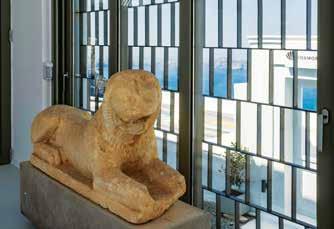
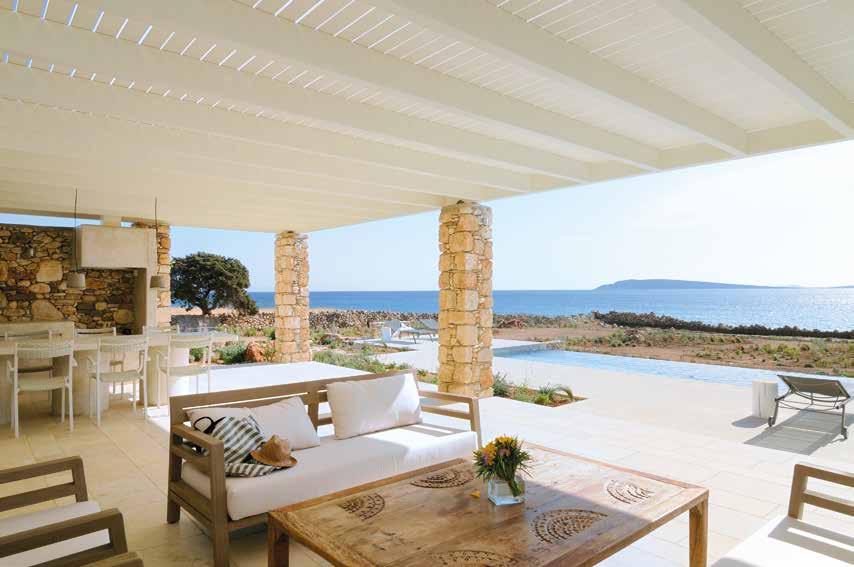


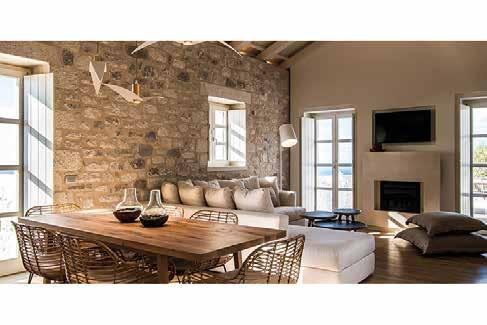
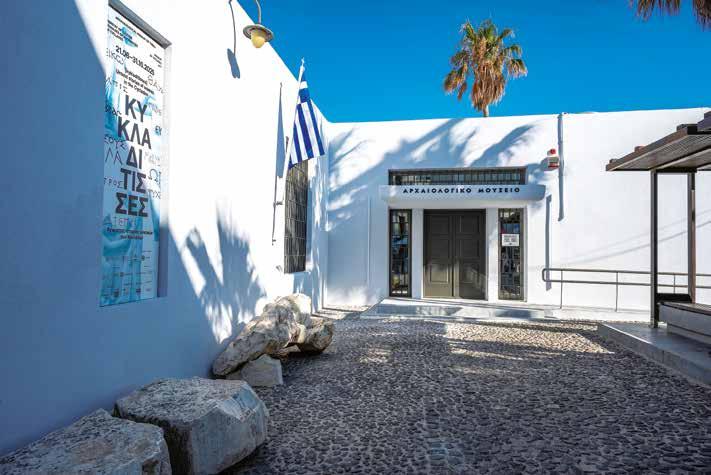
ditisses” and that the Kore of Thera could finally be placed in a permanent setting. Now, we conduct a museological study in order to determine the permanent exhibits that will surround the Kore when the “Kykladitisses” leave in October”.
“The cultural heritage of the Cyclades only comes to life for those who see it”
Dr Athanasoulis insists that, in order to benefit from it, we must integrate the past more actively into our daily lives. “It is now worth visiting Santorini just to see the new archaeological museum and its exhibits, which only come to life for those who see them. A direct and personal relationship is very important; it is not enough just to be proud of your history. Education and culture play a key role, as do the state and the people themselves. However, we often get distracted. Others come from abroad to see our exhibitions, yet we rarely go to see them ourselves. We must work hard to bridge the gap between the monument and modern people”.
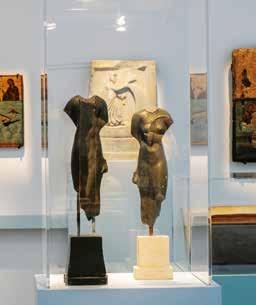
H Above: The Archaeological Museum of Thera after its renovation.
Left: Exhibits from Delos at the Archaeological Museum of Thera.







H Left: The statue of Artemis Elaphebolos from Delos. Below left: View of the exhibition “Kykladitisses” at the Archaeological Museum of Thera. Bottom right: The Director of the Ephorate of Antiquities of Cyclades, Dr Demetrios Athanasoulis.
The pan-Cycladic, emblematic exhibition, “Kykladitisses: Untold stories of women in the Cyclades”, a collaboration between the Museum of Cycladic Art and the Ministry of Culture’s Ephorate of Antiquities of the Cyclades, has travelled to Santorini for the inauguration of the renovated Archaeological Museum of Thera.
The exhibition, the first collaboration between the Museum of Cycladic Art and the Ephorate of Antiquities of the Cyclades of the Ministry of Culture, explores the history of the Cyclades through the eyes of its women from antiquity to the 19th century. It showcases 180 unique masterpieces from nearly all the museums and archaeological collections on the islands of Amorgos, Andros, Delos, Thera, Ios, Kea, Kythnos, Milos, Mykonos, Naxos, Paros, Serifos, Sikinos, Sifnos, Syros, Tinos and Folegandros. The exhibits date from the early prehistoric period to the foundation of the Greek state.
Three exceptional pieces take centre stage in the exhibition:
● The colossal Kore of Thera, which stands at 2.48 metres high and is one of the few surviving almost intact Archaic statues, is presented as a permanent exhibit in the renovated museum.
● The monumental fresco entitled “Women in the Adyton”, measuring 4 metres in length, was transferred to Thera as a tribute to the island’s prehistoric culture.
● The statue of Artemis Elaphebolos from Delos is a Hellenistic work being exhibited outside the island for the first time.
The exhibition “Kykladitisses: Untold stories of women in the Cyclades” will last until 31 October 2025.
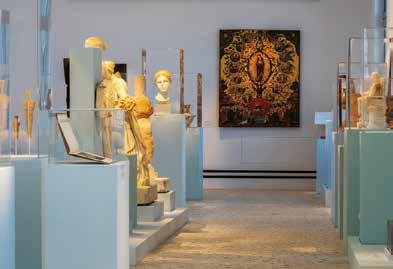

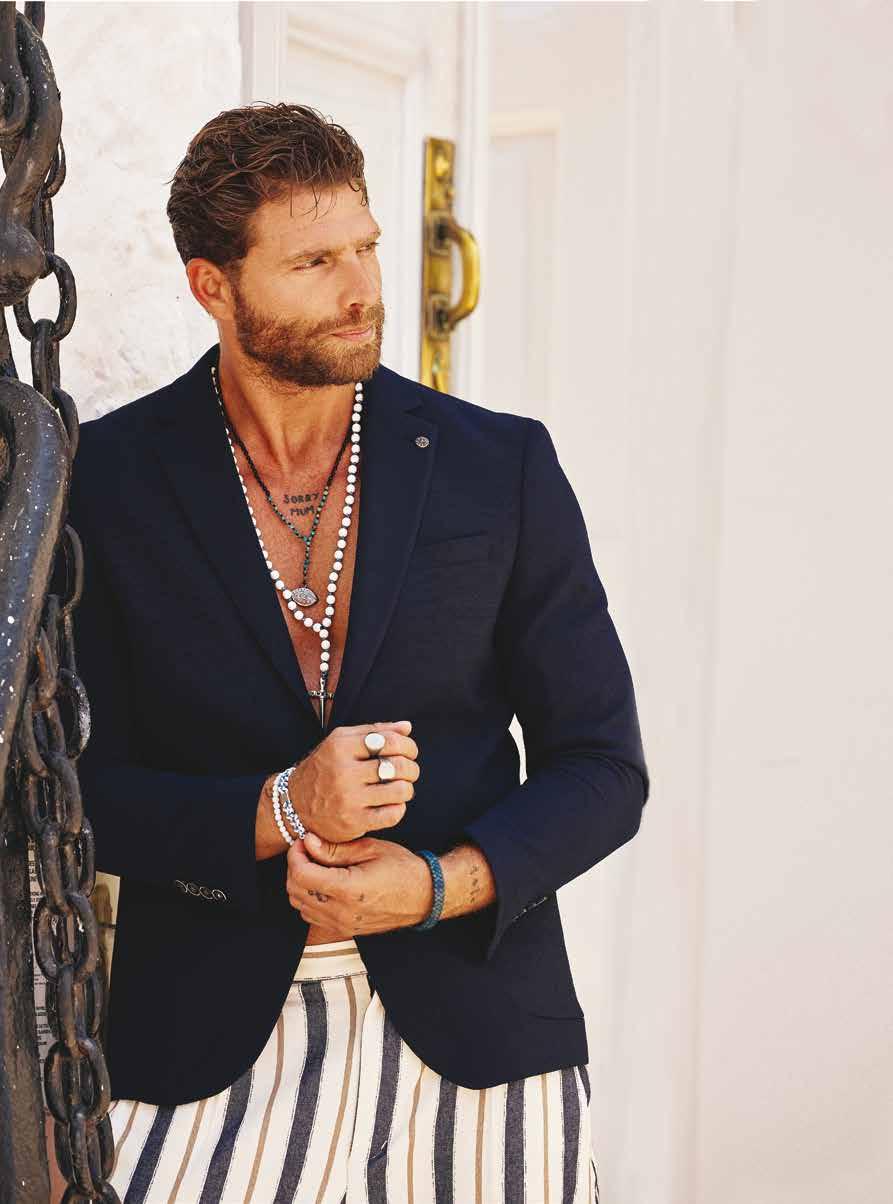
ΈΝΑ
BAN IMPRESSIVE BUILDING IN THE PORT OF TINOS HOUSES THE CULTURAL FOUNDATION OF TINOS, WHICH STUDIES AND PROMOTES THE ISLAND’S RICH CULTURE.
It is located on the waterfront, a jewel and the beating heart of the island’s culture, tradition and great people -artists, scientists and others. The Cultural Foundation of Tinos was established in 2002 by the Sacred Foundation of the Church of the Annunciation to research, study and promote the island’s history, art, culture and traditions.
In addition to its permanent exhibitions, the Foundation hosts a variety of events each year, including temporary exhibitions, musical performances, lectures and educational programmes. With four fully

H Cultural Foundation Of Tinos.


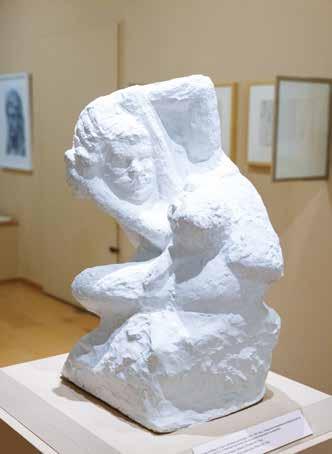
equipped conference rooms, it is also an ideal venue for conferences, exhibitions, seminars, cultural events and educational activities. Cultural Foundation of Tinos hosts three permanent exhibitions: one featuring works by the prominent sculptor Yannoulis Chalepas; one featuring paintings by Nikolaos Gyzis and Nikiforos Lytras; and one featuring contemporary artworks by Tinian and non-Tinian artists.
Since 2005, the Cultural Foundation of Tinos has been home to one of the largest collections of original works by Yannoulis Chalepas (1851-1938). The homonymous room exhibits 23 sculptures and 14 pencil drawings by the artist. They are all distributed across the three periods of the great Tinian sculptor’s artistic production, encapsulating the “greatest lesson on sculpture” (D. Pikionis). The exhibition is accompanied by photographs of Chalepas’s work by Ilias Iliadis. The lobby on the second floor features paintings by two Tinian artists, Nikolaos Gyzis and Nikiforos Lytras, from the Sacred Foundation of the Church of the Annunciation collection. Alongside the Fathers of Modern Greek Painting, there are three paintings by Nikolaos Lytras, the son of Nikiforos, which are considered milestones of the early 20th century.
Finally, the first floor exhibits works by contemporary Tinian and non-Tinian artists, which have been donated to the Cultural Foundation of Tinos, thereby confirming the island’s reputation as a centre of art, culture and letters.
This summer, until 14 September, the Cultural Foundation of Tinos is hosting a retrospective exhibition, “Ideas and Incidents”, featuring works by Babis Retzepopoulos (1940-2002), curated by Christoforos Marinos. The exhibition includes works from the period 1957-1994, as well as four pieces by A. Tassos, the engraver who was Retzepopoulos’s teacher at the Doxiadis School.
Babis Retzepopoulos, a painter, engraver and graphic artist, came into the world at a time when light was fighting darkness. He was born in Athens on 27 December 1940. This archetypal duality of light and darkness, light within darkness and the path from darkness to light, formed the main axis of his artistic thought and creation. Even in his early paintings, Retzepopoulos impresses with his handling of colour and, above all, his willingness to experiment. His compositions are well-crafted, robust and layered, as are the engravings he began making in subsequent years. We know of about twenty of the woodcuts that he made while living in Athens during his studies at the Doxiadis School and later (1962-67). During his time in Paris

H Detail from “Fairy Tale of Sleeping Beauty II” (left) and “Satyr and Eros V” (above left) by the renowned sculptor Yannoulis Chalepas.
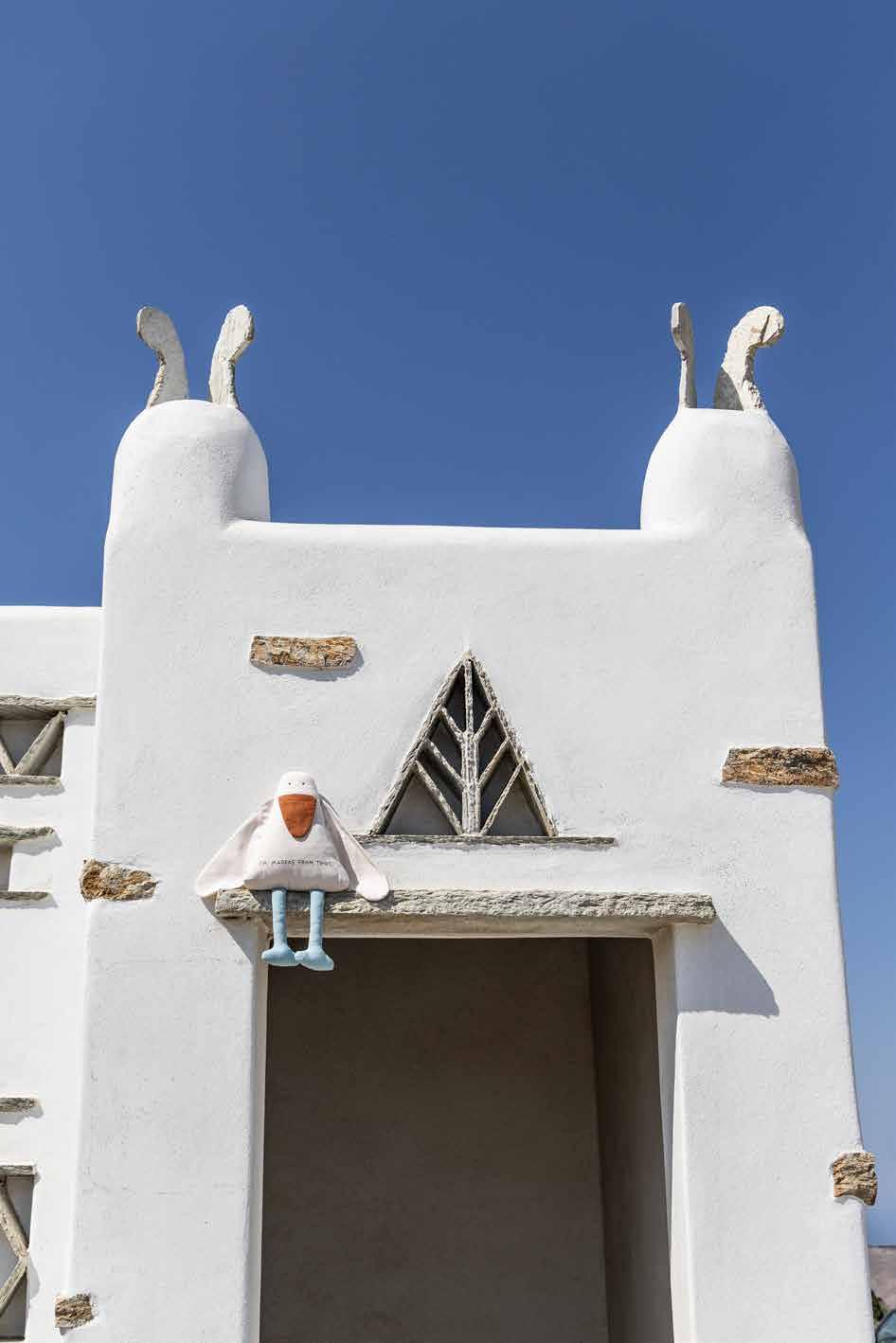

(1968-73) and during the early years of the Metapolitefsi (political transition) period (1975-78), when he was living in Tinos, he produced a further forty woodcuts of a representational nature. Retzepopoulos’s engravings acquire a different and certainly closer relationship with light when, in the late 1980s, he adopts an abstract style -a bold, original approach that is distinguished for its poetic quality.
εκτίθενται έργα

However, the Cultural Foundation of Tinos’ activities inside and outside the walls are multiple and varied. The Foundation organises the Jazz on Tinos and Tinos World Music festivals (tinosjazz.com and tinosworldmusicfestival.com respectively), the longest-running events of their kind in the Aegean. They provide an opportunity for the local population and visitors to the island to get acquainted with new musical sounds, while also serving as a meeting point.
In the recently renovated shop of the Cultural Foundation of Tinos you can buy unique gifts, such as exact copies of works by Yannoulis Chalepas and miniatures, catalogues of the exhibitions of the Foundation, books about Tinos and its culture, postcards and posters. Furthermore, there are works of contemporary Tinian marble



αντιμαχόταν
sculptors, jewellery by Tinian and non-Tinian artists, souvenirs inspired by the collection of works by Chalepas, and other elegant, original and useful objects by distinguished artists. All excellent examples of the artistic and cultural sensitivity of Tinos and the Cyclades in general.
Cultural Foundation of Tinos, Akti G. Drosou, Tinos, Itip.gr

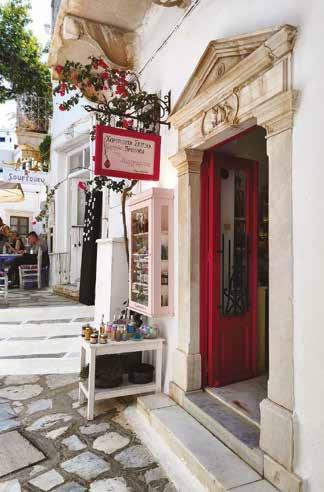

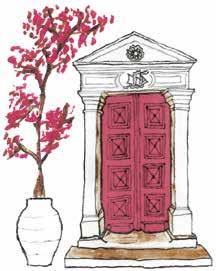
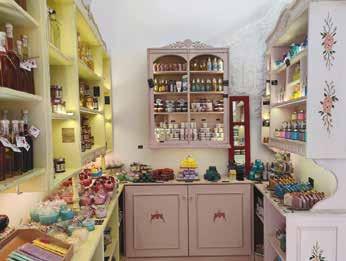
Margarita’s Handmade Homemade Products began their journey in Pyrgos, Tinos, in 2017.
As you approach the village square and the shade of the plane tree, you will be welcomed by the aromas of our handmade soaps and candles. Here you will find a wide range of herbal cosmetics, as well as traditional savoury and sweet flavours. Crafted with love and care, they invite you to embark on an exploration from yesterday to today.
We are here to help you with your choices.
Tinos Pyrgos, 84201, Greece Tel.: +3022830 31885 www.tismargaritas.gr

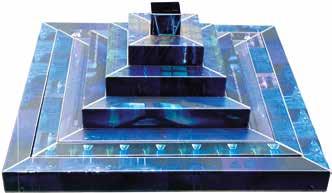
THE PLOES ARTISTIC PROJECT RETURNS TO THE P. & M. KYDONIEOS FOUNDATION FOR ANOTHER YEAR WITH THE “LUMEN DE LUMINE / LIGHT FROM LIGHT” EXHIBITION, FEATURING THE WORK OF 31 ARTISTS.

ndros has repeatedly proven itself to be a popular destination for art lovers, consistently presenting significant visual works by Greek and international artists. This year the exhibition the “Lumen de Lumine / Light from Light” is under the auspices of his excellency the President of the Hellenic Republic, Mr Constantine An. Tassoulas, at the P. & M. Kydonieos Foundation in Chora, Andros, as part of the Ploes project, which is in its 31st year.
The exhibition, which features the work of 31 artists in the form of paintings, sculptures, engravings, ceramics, photographs and in

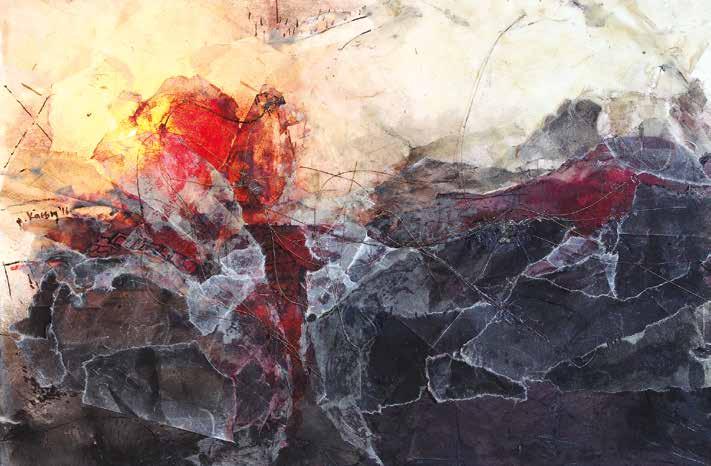
stallations, will run until 28 September 2025. It is curated by Athena Schina, a Historian of Art and Theory of Culture.
Through the ingenuity of their idioms and thematic choices, the participating artists express the “Lumen de Lumine / Light from Light” individually, mobilising the spectator’s thoughts, reflections and imagination. Besides, the aim is, apart from the aesthetic pleasure that the exhibited works can offer to the viewer, to make them reflect by broadening their associations, correlations and perceptual capacity. The Kydonieos Foundation was established in 1994 by Petros and





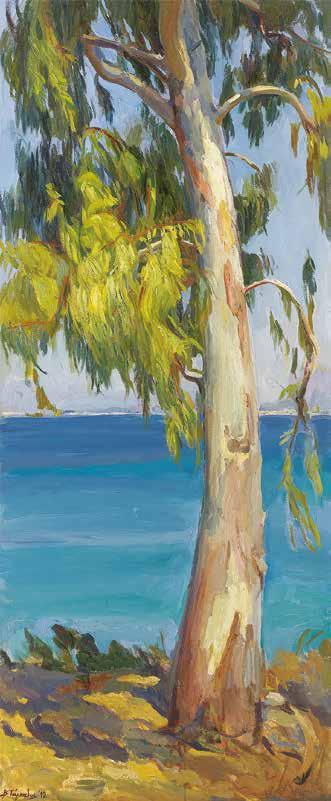
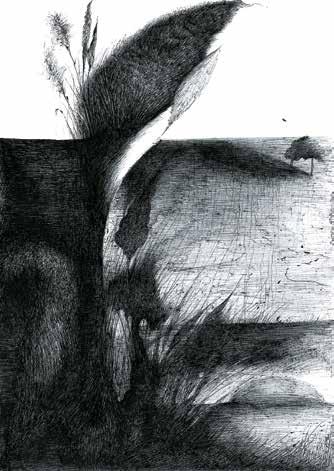
Marika Kydonieos with the aim of providing a cultural and spiritual centre on the island of Andros. The Foundation’s mission is to promote culture, with a particular focus on the visual arts, music, theatre and literature. Furthermore, the Foundation offers free courses in ceramics and musical instruments, as well as scholarships for children from Andros who pass the entrance exams for higher education institutions.
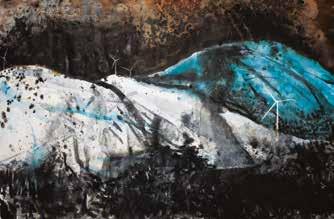


SAXOPHONIST HARRIS ATHANASOPOULOS SPENDS HIS SUMMERS IN IOS, FILLING THE MOST BEAUTIFUL MOMENTS OF VISITORS’ HOLIDAYS WITH WONDERFUL MUSIC.

Hos is a rather misunderstood island, mainly due to its reputation for frantic nightlife. This often prevents us from imagining it differently and focusing on its rare beauty and special aura. However, we found someone who could talk to us about Ios from the heart, challenging all the stereotypes. Harris Athanasopoulos is a musician. He started with the bouzouki, then moved on to percussion, developing a particular affinity for Latin sounds. He eventually took up the saxophone, while staying


within the world of wind instruments he also plays the trumpet and the clarinet. In winter, he teaches at conservatoires and schools. For the last 15 summers, he has been playing the saxophone for enthusiastic audiences from all over the world in certain parts of the Cyclades.
“I started playing the saxophone fifteen years ago in shops in Naxos. For the past four years, I have primarily been based in Ios, specifically at the Ios Club. Ios won me over because it has the most beautiful atmosphere of any island I have ever visited. There are many ceremonies every summer and it’s wonderful to accompany people who are getting married on such a special day with your music!” he says.
So what won him over in Ios? “Ios calms my mind. There are some places here that you won’t find on other islands. Mylopotas Beach -if you make the right move and wake up early, you can have it all to yourself! The magical route from the port to the Lighthouse is also an excellent hiking route. If you prefer walking, the wonderful landscape will be your reward. Tzamaria Beach is just 15 minutes from the port and boasts clear blue waters. The huge advantage is that it never gets windy. Although I come to work in Ios, I am looking forward to being here because no other place on the map calms me like this”.
As for the historic Ios Club, where he is a regular professional during the summer months: “It is one of the most famous clubs. It is located in Chora and was built in an amphitheatrical style at a... vantage point. It started as a shack in the hippie era, during the island’s and Greece’s purest years, and has evolved into a unique sunset dinner club with breathtaking views. You can see the entire port from above. Famous musicians such as Sting’s band members, Manchester United footballers and famous actors have been here. It combines beautiful vibes and a rich history”.
What is it like to meet so many people from different countries on one of the happiest days of their lives? “The 99% of events are aimed at visitors from
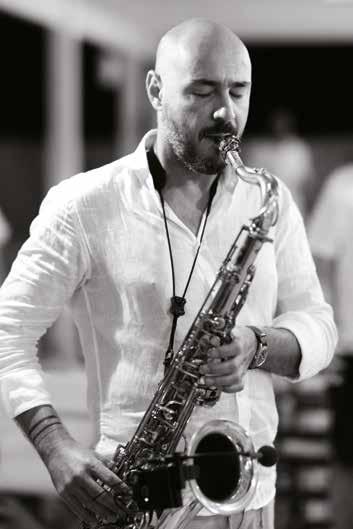
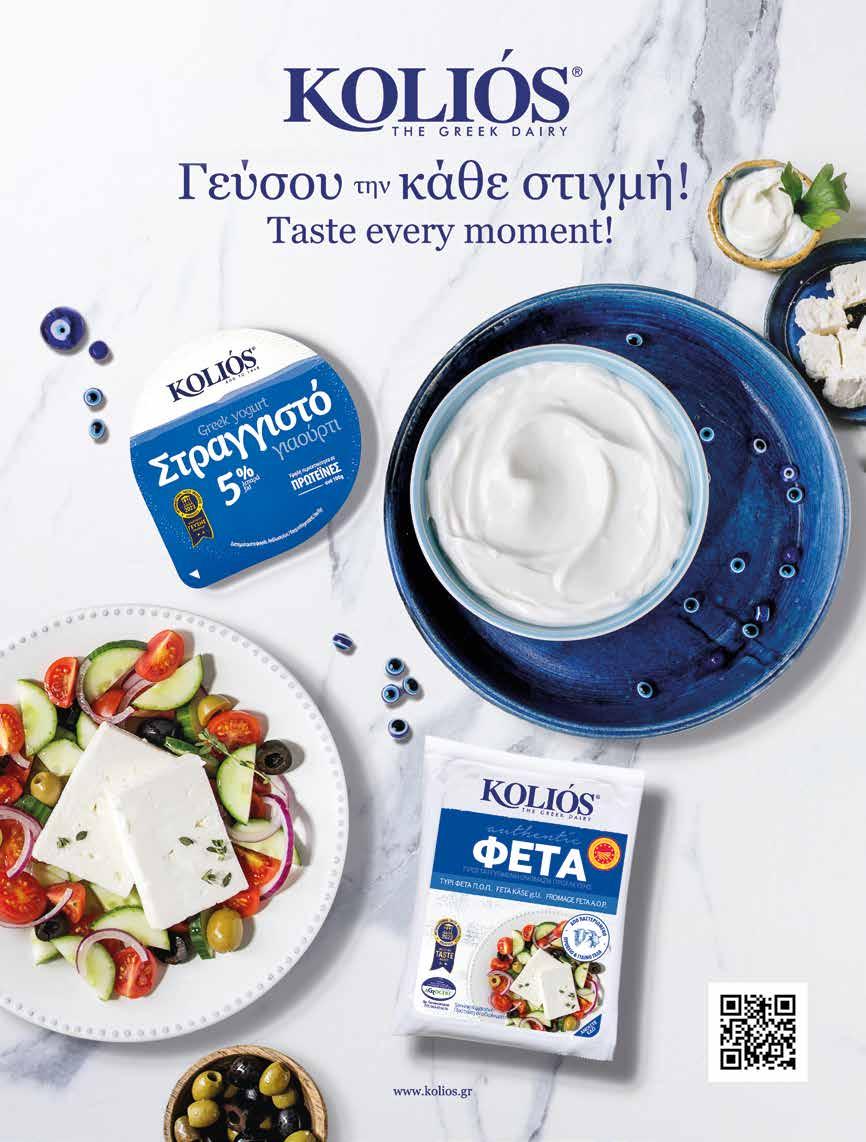
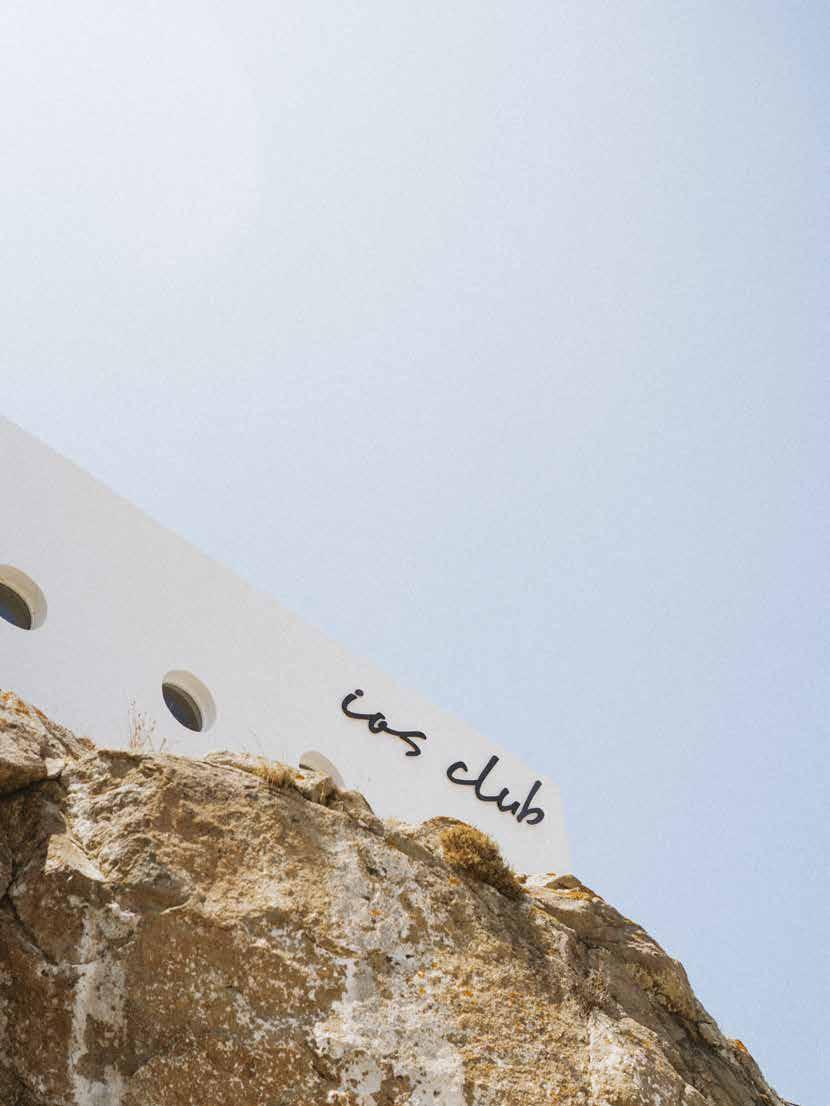
Instagram: harrissax harrissax.gr

abroad. Unlike Greece, the saxophone is a familiar instrument to foreigners and is closely associated with their culture. Therefore, Greek saxophonists tend to be very popular during the tourist season! You play music for foreigners who met their soulmates on the island. Or who took their first trip to the island with their other half. Or even, for those who have distant origins from Ios and wanted to discover their roots. Most people who decide to organize such an event are married with children and essentially hold a beautiful ceremony as a gift to their closest friends. In other words, you invite your closest friends and family to the island, where you celebrate everything you are grateful for in a beautiful and friendly atmosphere. This experience cannot be compared to huge weddings with 500 guests”. When he is not entertaining his large audience and making them fall in love with his saxophone, he loves to return to the same places, “if possible, to sit at the same table, in the same chair, and eat the same food. Ios has a wonderful tranquillity”.
Before we leave him to return to the beauty of his beloved island, he shares a fascinating observation with us: “Due to overtourism in Santorini over the last two years, a large number of visitors have been taking the boat over to Ios to relax”.
Instagram: harrissax
harrissax.gr

Memi Papakonstantopoulou
FINANCE & TAX CONSULTANT
PROJECT
MANAGER

(Business Plan, Feasibility Studies, Execution)
Real Estate Project Manager
TAX Advisor
ACCOUNTING Services for Companies (SA, LTD, Personal, etc)
Bank,Private Institution Financing
HRM-Payroll-Labor Law issues
PR-Marketing-Sales
Legal Services
NPL Restructuring &Refinancing
ESPA( European Grants) Project
2 Pallados str., 84200, Chora, Tinos, Cyclades Agios Romanos, 84200, Tinos, Cyclades T.: +30 22830 25980 - 1, +30 6947 904 495
23-25 Eponiton str., Alimos 17455, Athens T.: +30 213 0308 985, 211 1188 656, 211 0010 086
Email: info@memitinos.email, info@mpfinance.group, info@mpfinance.tax www.mpfinance.tax
A
THE SCULPTURE EXHIBITION BY VENIA DIMITRAKOPOULOU “BEATING ON THE WINGS OF THE MIND AND ART” AT THE ARCHAEOLOGICAL MUSEUM OF PAROS ENGAGES WITH EMBLEMATIC FIGURES AND FORMS IN A CONTEMPORARY YET TIMELESS MANNER.
H ΒY ASTEROPI LAZARIDOU
The Archaeological Museum of Paros, which houses priceless treasures, is hosting a sculpture exhibition by Venia Dimitrakopoulou: “Beating on the wings of the mind and art”, organised by the non-profit association “Friends of Paros & Antiparos” and kindly supported by the Ephorate of Antiquities of the Cyclades.
Visitors to the exhibition, which is curated by Eleni Varopoulou, will have the opportunity to examine and admire four sculptural works: “Resting Nike”, “Wing of Myth”, “Perpetual Flight”, and “The Message of Dawn”. These are Venia Dimitrakopoulou’s latest creations, presented in dialogue with the museum’s iconic exhibits and the unique Cycladic landscape.


“Two lines define the natural landscape of the Cycladic space. One is the straight line. The other, the curve. A straight line is the horizon, that of the sea. Curves are the countless rounded angles in the rocks, the mountains, the characteristic buildings of the Cycladic islands. A relentless, dazzling, cathartic light calls for folds in fabrics, fluting on columns, and gives birth to the unimaginable play of light and shadow in sculpture”, notes Venia Dimitrakopoulou for the beauty that inspired her.
In both the museum’s halls and its courtyard, where the exhibition is taking place, the
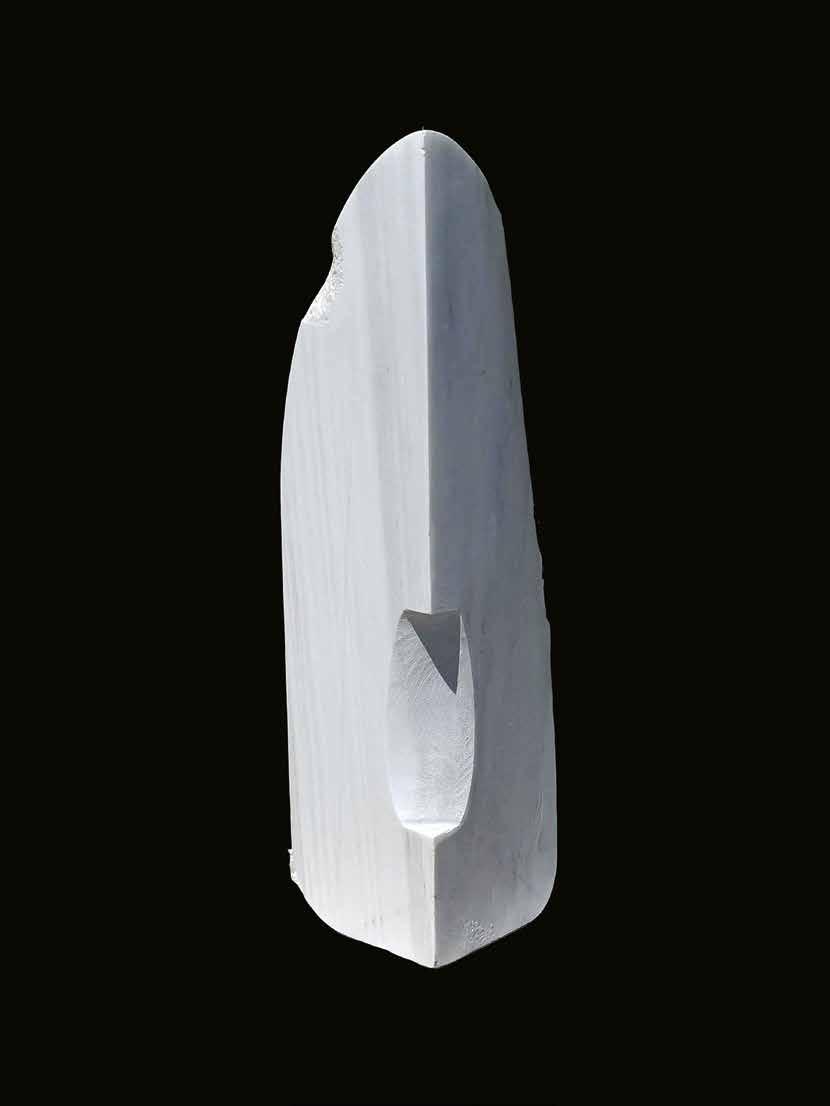
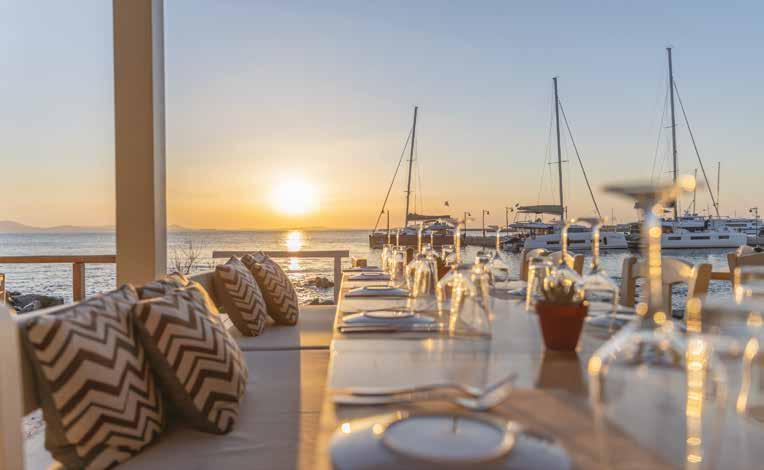


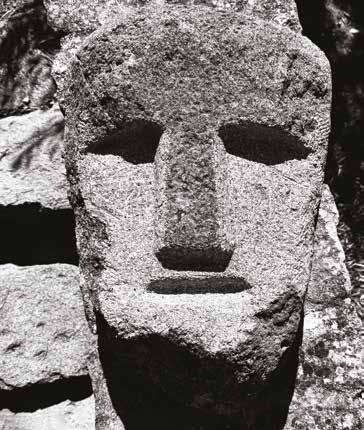
multifaceted artist is presenting her new works carved in Pentelic marble, as well as her Indian ink drawings on handmade paper, titled “Lines of Thought”, and six sculpted heads carved from volcanic stone, which are characteristic of her work.
“In Parikia, within the halls of the Archaeological Museum, as visitors move among archaic korai and kouroi, they encounter Nike -the trophy erected in remembrance of the Parian victory over the Athenians. They also study the priestly, mysterious Gorgon with wings folded backward. Amidst these, they encounter Venia Dimitrakopoulou’s contemporary sculptures: wings in motion for an ethereal journey upwards, and a wing spread horizontally in repose”, notes the curator of the exhibition, Eleni

σινική
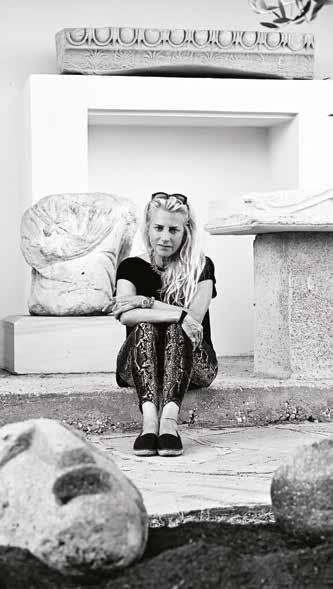
Varopoulou, conveying the atmosphere of the exhibition.
The musical composition of Panagiotis Kalantzopoulos, created especially for the occasion, masterfully completes the experience of the visit. “Sculpture should not only be seen -it must be heard. The sound of the works is the wind, the insects, the footsteps, the light. It’s a song without words, where the lyre takes the place of the human voice” points out the composer, who has worked with the sculptor in the past. Visitors will also be able to access the orchestral piece via QR code, which will complete this original audiovisual experience. An illustrated, bilingual (Greek-English) catalogue accompanies the exhibition.
This is more than just an exhibition; it is a journey through time, accompanied by light, history, myths, and the charming reality of the beautiful Cycladic island.
“Beating On the wings of the mind and art”, Archaeological Museum of Paros, Parikia, until 19 August 2025.


2023. H Reflecting the Delian Sea. Blue hour. June 2023.

ERIETA ATTALI.
THE SACRED ISLAND OF DELOS IS PRESENTED IN A NEW LIGHT THROUGH THE CREATIVE LENS OF THE DISTINGUISHED PHOTOGRAPHER ERIETA ATTALI.
rom September 2022 to May 2025 Erieta Attali created images that capture the interaction of both sun and moonlight on the Cycladic islands. It is there that temples address not only the land on which archaeologists dig but the sweep of the horizon and the glistening of the sea”, says Professor Barry Bergdoll, who holds the Meyer Schapiro Chair in the Department of Art History & Archaeology, at the Columbia University in New York, about the work of the internationally renowned photographer currently on display at the Benaki Museum of Greek Culture in Athens.
Under the title “Delos | Land adrift”, the exhibition -curated by Erieta Attali herself and Lambros Papanikolatos- invites visitors to encounter Delos

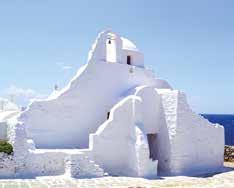


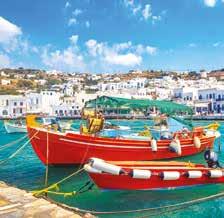

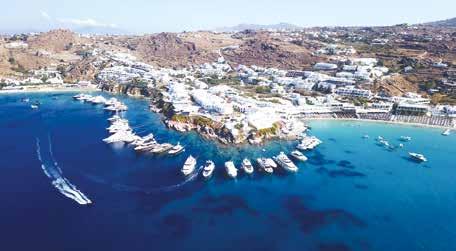


H The Theatre of Delos, having Rheneia as scene. October 2023.

not only as a destination but as a passage: an island adrift between light and shadow, Earth and sky, the ancient and the eternal. Through her lens, Attali captures the island’s sacred aura, offering a visual narrative that is at once archaeological, lyrical, and profoundly timeless.
Visitors to the exhibition will have the opportunity to see 25 large scale prints by Erieta Attali, a 7-minute film by Elizabeth Tsouctidi, and a cartographic mapping designed by architect Aris Kafantaris. Also, it is accompanied by texts by Barry Bergdoll, Georges-Stylianos Prevelakis and Dimitris Philippidis. The architectural design of the exhibition was created by Tasos Roidis.
Professor Barry Bergdoll, notes about the photographer’s work: “... For Erieta Attali
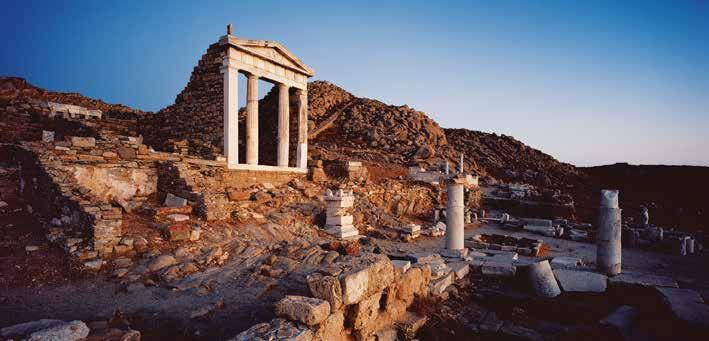
H The district of foreign gods, the Temple of Isis, Mount Kynthos. October 2024.
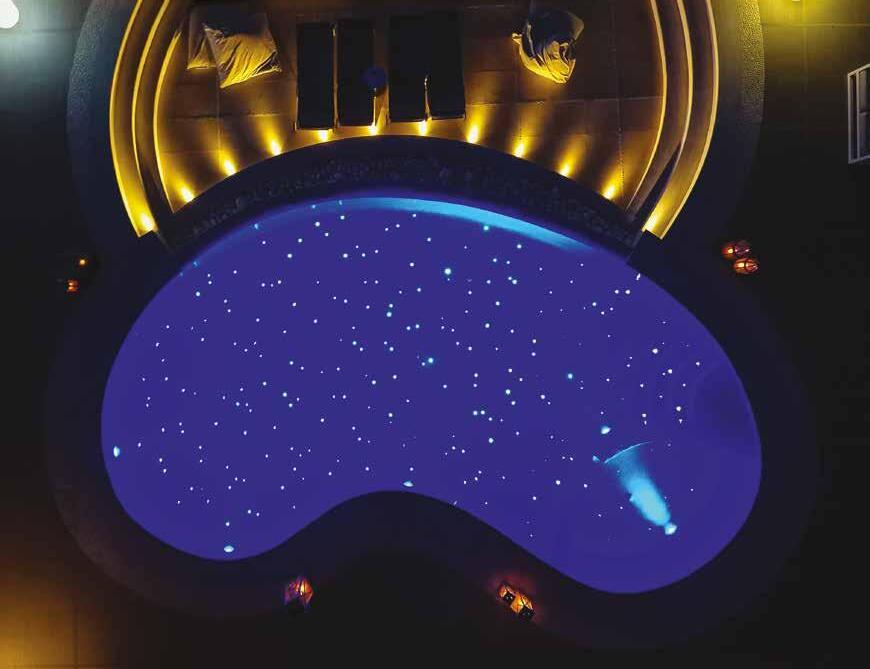
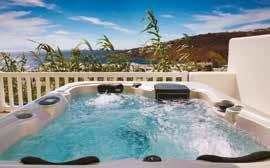
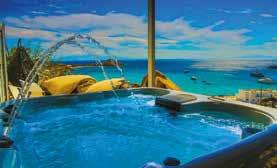
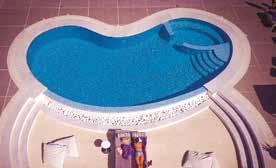
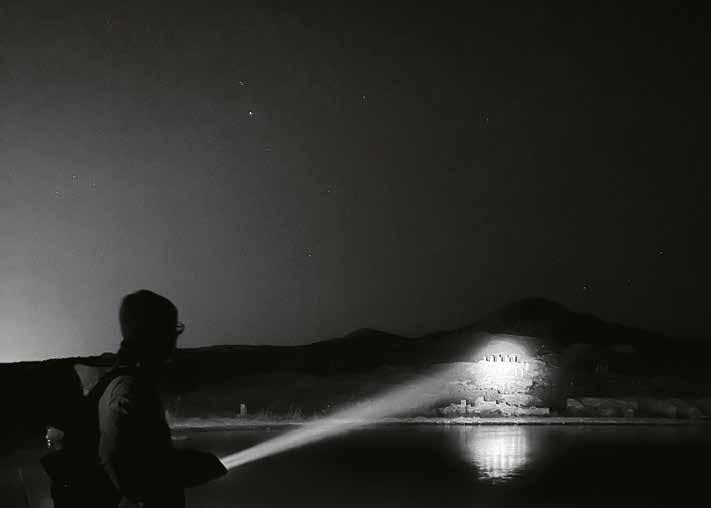
Erieta Attali to make images of an archaeological site goes far beyond literal documentation. She captures a topographical vision, extending to the horizon, or even on the open sea and the sense it gives us of the curvature of the earth. Erieta Attali’s photographs are as much of the sites recorded as they are about the spirit in which the ancients occupied the Cyclades, the islands of the Aegean”.
For the past thirty years, Attali has devoted herself to exploring the relationship between architecture and landscape. Through her pi -

2023.
bleu. At the centre of the Cyclades. June 2023.




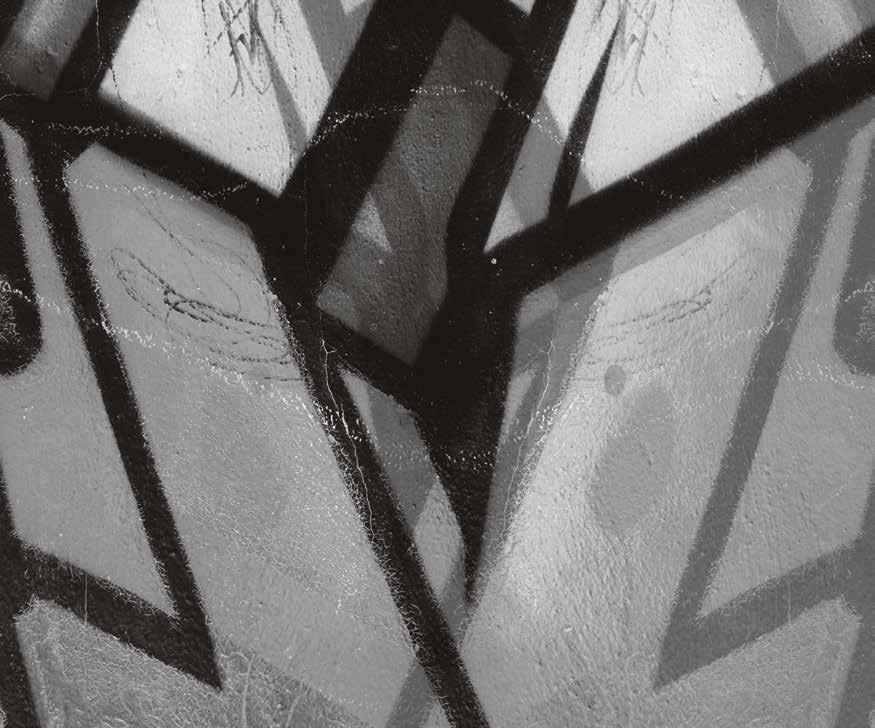
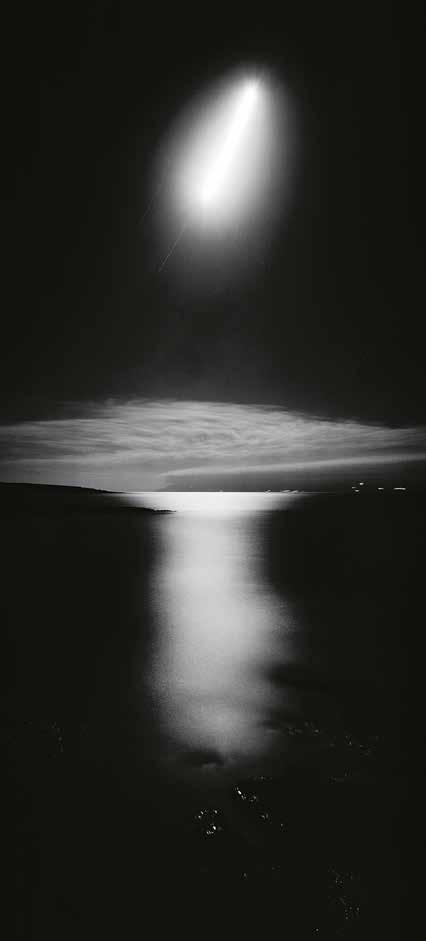
and Apollo in the centre of Cyclades, night view from the Northern shore of Paros. December 2023.
oneering work, she has forged a new path in architectural photography where content and context are inverted. Her photography explores how extreme conditions and challenging terrains cause humanity to reorient and recentre itself through architectural responses. Her unconventional photography is based on a working method drawn from her experience in archaeology. She has taught photography to some of the leading institutions worldwide such as Columbia University and the National University in Singapore. Her work has been exhibited in major museums and is held in the permanent collections of the National Gallery of Victoria (Melbourne, Australia), the Philadelphia Museum of Art, and the Chicago Athenaeum Museum of Architecture and Design (USA). Attali is currently preparing her new photography monograph about the work of the surrealist painter Felix Nussbaum.
“Delos | Land adrift”, until 21 September 2025, benaki.org

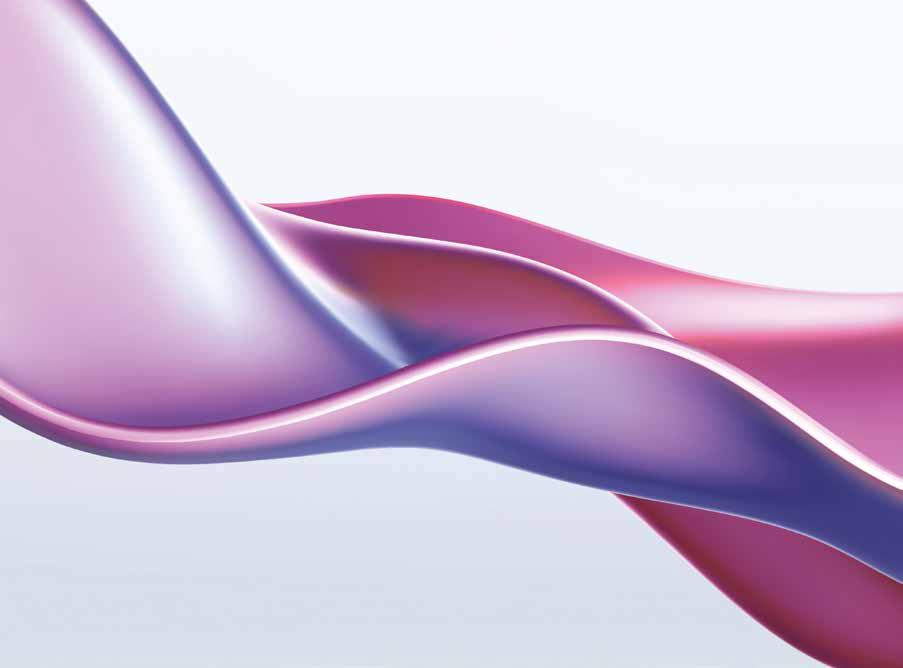




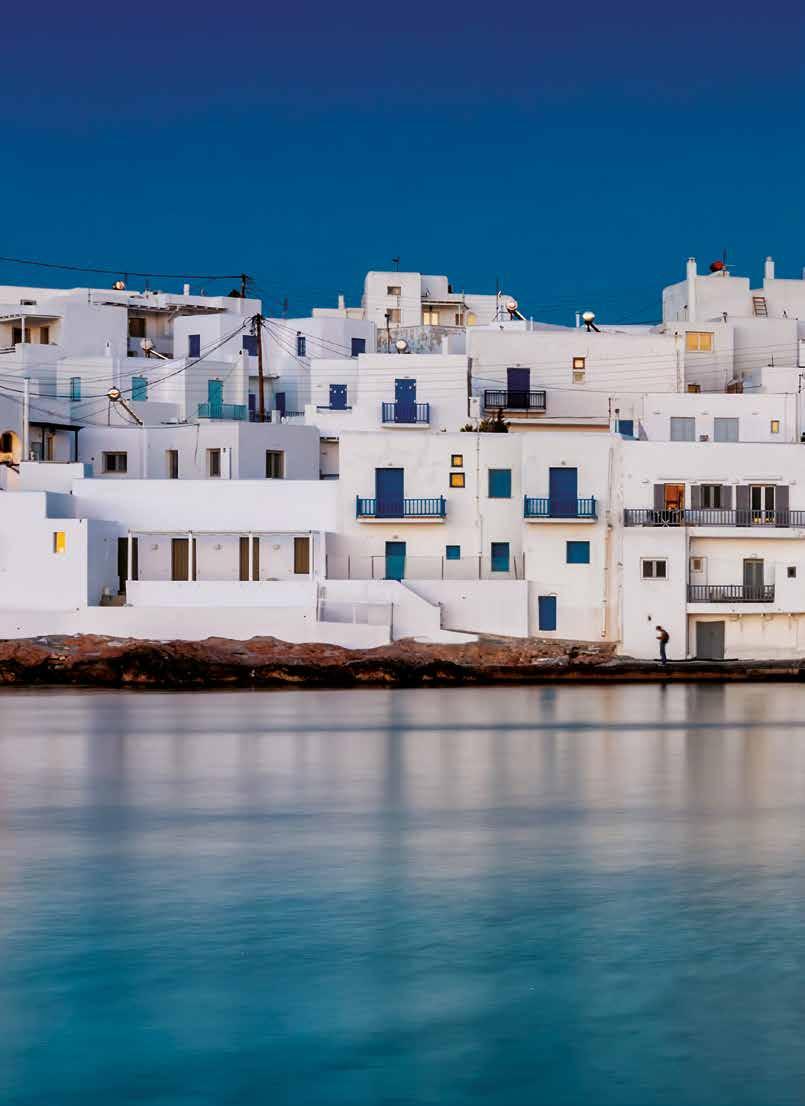


WE SET SAIL FOR THE MOST POPULAR OF THE CYCLADIC ISLANDS, PRESENTING OUR ITINERARY OF ITS MOST BEAUTIFUL SPOTS.
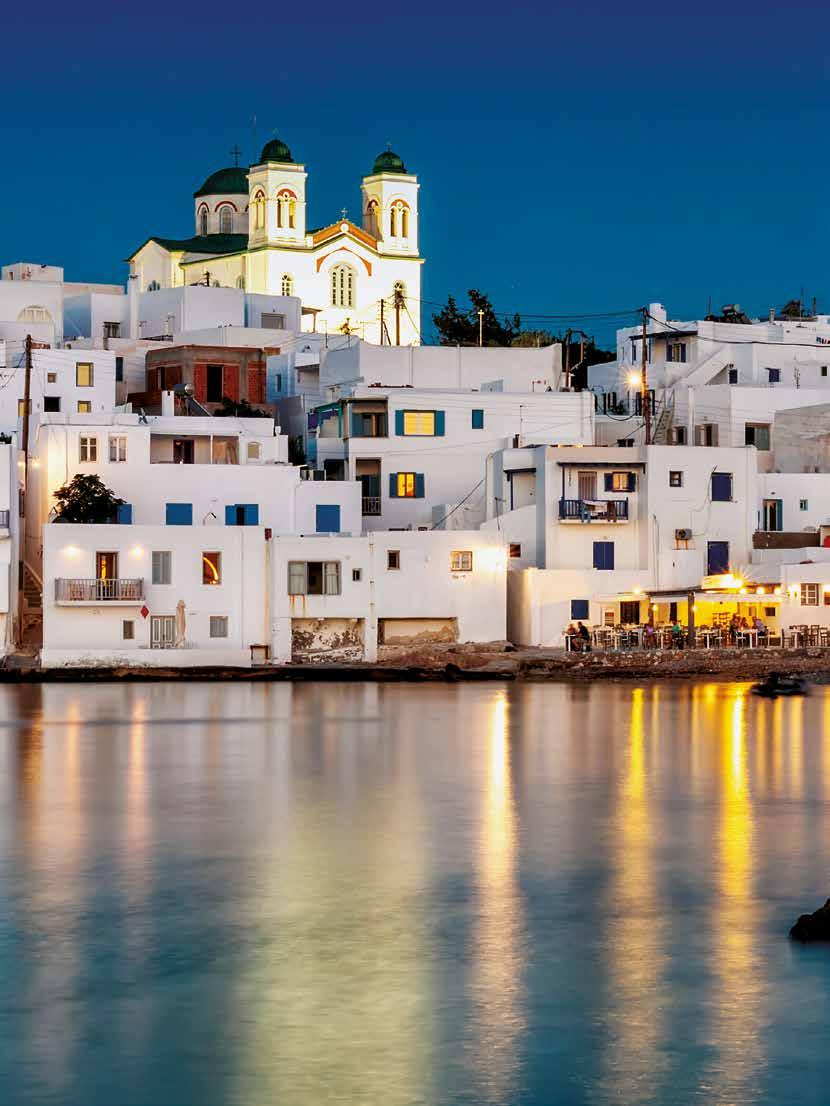
AAncient marble quarries, traditional inland villages, stunning beaches with crystal clear waters, picturesque and cosmopolitan seaside villages, unique traditional flavours and dreamy sunsets. All this -and much more- in Paros. Join us!
Day 1 On a hot summer’s morning, the Golden Star Ferries ship docks at the port. The large crowds cannot dampen our excitement to explore the jewel of the Cyclades. Before anything else, we take a dip in the cool waters of Livadia, an almost serene beach despite all the beach bars. The sea is shallow yet impressively refreshing, and the water is crystal clear despite being next to the port. A small snack is enough to continue our way to the ancient marble quarries in Marathi. This area is home to the underground mining galleries of the quarries of the Nymphs and Pan, where the famous Parian marble was mined from the 7th century BC, renowned for its white colour, excellent transparency and clarity, which has been used in masterpieces of architecture and sculpture, including the Hermes of Praxiteles, the Winged Victory of Samothrace and the Venus de Milo. We walk along paths lined with bushes, lentisks and aromatic plants. We observe the rocky galleries from the outside as, for safety reasons, entry is not permitted. We continue on to Kostos village, where we find a picturesque square, the church of Agios Panteleimonas, children running happily through narrow streets between well-tended houses and a traditional coffee shop under the trees, where we enjoy a cool glass of lemonade. Then, we stop on the slope of a hill to admire the unique view of the valley and sample the delicious Parian chickpeas, which are slowly cooked in the traditional skountavlos (clay baker). Now it’s time to visit Lefkes, another dreamy village and one of the most beautiful in the Cyclades. Built in an amphitheatre-like



formation, it features a panoramic view of the archipelago. Bathed in the light of the evening, the impressive Church of Agia Triada (Holy Trinity) stands out from afar. As we descend towards the main square, we come across one of the summer festivals, where young children are dancing traditional island dances under the towering, centuries-old trees. Crowds of people enjoy local delicacies in traditional coffee shops or admire elegant stores offering highquality souvenirs. Happy laughter and voices can be heard everywhere. It’s a summer night worth living for, with the full moon lighting up the marble streets between whitewashed traditional houses and flower pots scenting the air. If you find yourself here on the first Saturday after 15 August, you can enjoy the traditional Parian dish of karavoloi (large snails) cooked in garlic sauce at the Feast of Karavolas.
Day 2 We start the day early with a visit to the Archaeological Museum in Parikia, a real jewel of a museum. Here, we can admire the marble masterpieces created by Parian sculptors in ancient times. Among them are the impressive Archaic Gorgon, which struck terror into anyone who saw it; the Kouros, whose forms are wonderfully plastic; and the Victory, who seems to have just come down from the sky and is hovering forward. The majestic shadow of a palm tree is cast across the courtyard alongside the other exhibits. The island’s archaeological wealth seems endless: near the car park, in a fenced area, we can see impressive mosaic floors dating back to Hellenistic times.
As we travel northeast from Parikia, we enjoy the Cycladic landscape. We make a detour to the exotic Lageri on the way.
EVY TECHNOLOGY® – The Sunscreen Revolution from Sweden
Traveling through the Greek islands under the dazzling sun? Whether you’re soaking up the rays on deck or exploring seaside villages, your skin deserves more than just SPF.
EVY Technology®, powered by patented EVYDERM TECHNOLOGY®, delivers advanced, clinically proven protection that lasts up to 8 hours, even after swimming, sweating, or wind exposure.
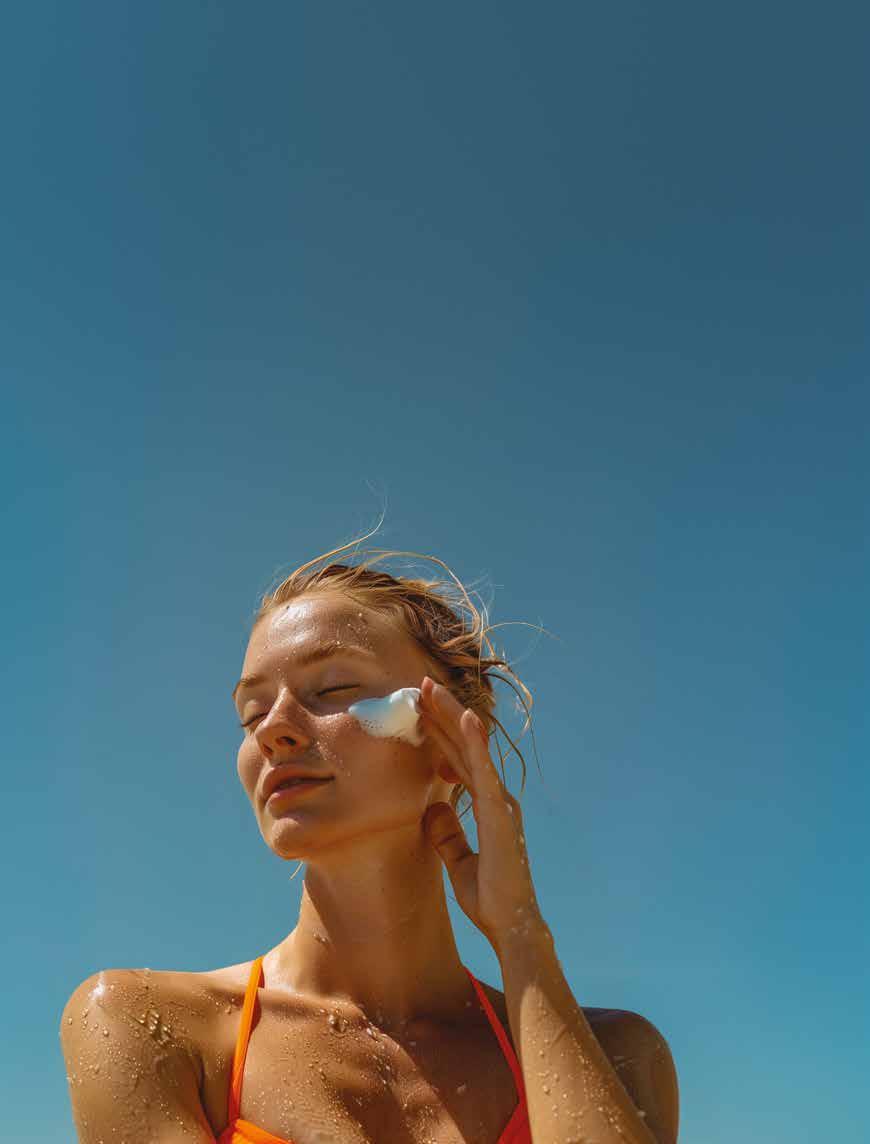

Skin Barrier Repair (helps nourish and rebuild compromised skin)
Wrinkle & Pigmentation Defence (Preserves collagen, reduces fine lines)
Highest UVA Protection Available Rated 90% UVA protection, verified by the Boots Star Rating System (5 Stars) and PA++++ standard
Suitable for all skin types – even sensitive skin
Non-comedogenic, free from parabens, alcohol, fragrance, and allergens


GET IT NOW –QUICK, EASY & SECURE Scan the QR code to explore and order EVY online.

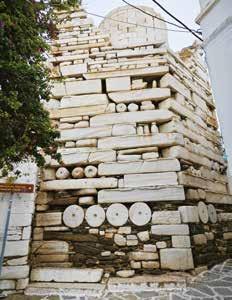
With its blue waters, sand dunes and tamarisk trees, the Caribbean-flavoured beach is peaceful and inviting at this time. Later on, we pass by Santa Maria, where windsurfers ride the waves (as well as at Golden Beach and Pounta, which are popular with kitesurfers). We reach the tiny golden shore of Little Santa Maria, with its tamarisk trees, sea lilies and rock pools, and dive directly into the turquoise waters of the secluded bay. And yes, our dive is infinitely refreshing. The small boat sinking into the sand next to the cedars adds to the relaxing scenery.
On our way back, just before sunset, we stop to enjoy the smell of the sea and savour a hearty lobster spaghetti. Opposite us, we are treated to the most beautiful sight: a small wooden quay shimmering in the last sunbeams and a seabird screeching with delight at its generous catch.
Back in Parikia, the picturesque alleys are an extremely tempting spot for an evening stroll. The whitewashed churches are all open to visitors and the candles inside are smouldering, exuding a sweet warmth. In the tranquil old town, we ascend to Frangokastello (1260) and admire the surviving defensive tower, which features embedded marble columns, as well as the ruins of churches with a long history. We then walk alongside the
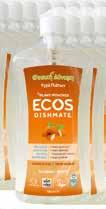

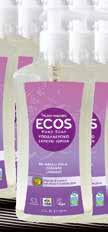





surviving walls, which once formed part of the medieval settlement around the castle (xopyrgo), and travel back in time to when Markos Sanoudos founded the Duchy of the Archipelago and Paros was raided by merciless pirates. As we walk through the settlement, we can see the three marble fountains donated by Nikolaos Mavrogenis, the Parian ruler of Moldavia. We can also see the house where Manto Mavrogenous, the heroine of the 1821 Revolution, lived in the last years of her life. All this coexists harmoniously alongside stylish little shops and orange bougainvillea climbing white walls adorned with blue doors and windows. We enjoy one last drink on the lively waterfront and make plans for the next day.
Day 3 After visiting the Holy Shrine of the Virgin Mary Ekatontapyliani, one of Greece’s oldest and most impressive Byzantine monuments, we head to the Valley of the Butterflies to admire these colourful creatures. We observe them resting among the lush ivy, wild olive, pine and wild fig trees, which stand out amongst the cypress, mulberry and pomegranate trees. A cat watches our every move, as if it were the lazy guardian of the park.
After enjoying this serene oasis, we will head south. We immerse ourselves in the turquoise, crystal-clear waters of Faragas, the bay surrounded by rock formations ideal for exploration, with background music from the beach bar. At the same time, however, we watch -and rather envy- some boats heading for a smaller, secluded beach. Having
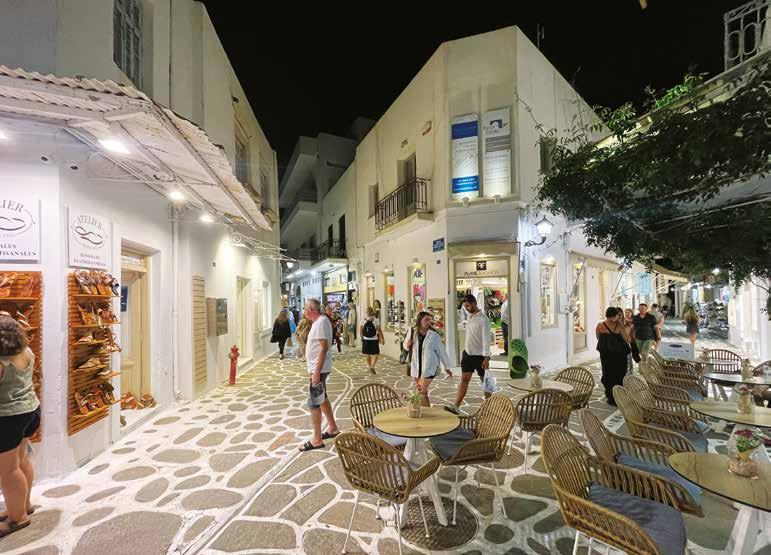
The picturesque alleys of Parikia.
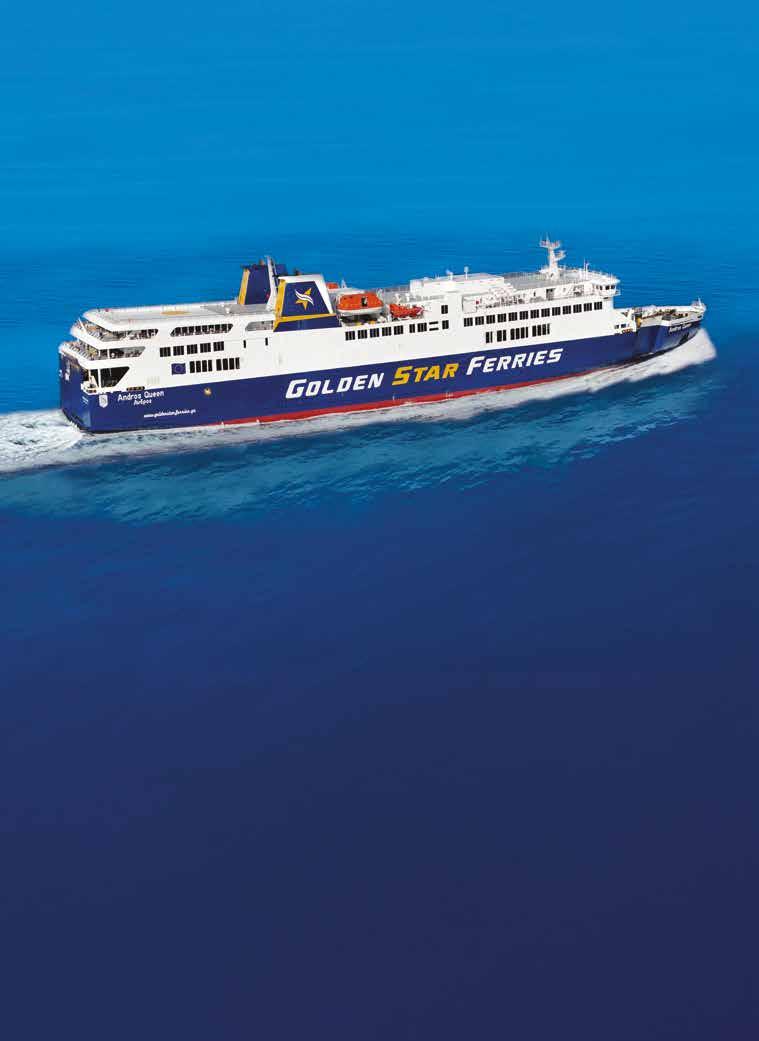

worked up an appetite with all the dives, we enjoy fish delicacies in Alyki, a small harbour 2.5 km away.
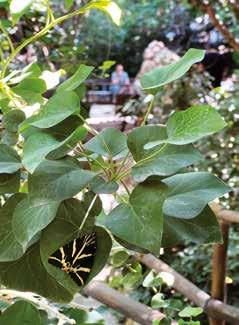
H The Jersey Tiger Moth in the Valley of the Butterflies.
After a short rest, we’re back behind the wheel to visit the picturesque yet cosmopolitan fishing village of Naoussa. The sunset here is a ritual –with an orange-coloured cocktail in hand to match the colourful palette painting the fishing boats, the humble yet much photographed chapel of Agios Nikolaos, the half-submerged Venetian castle, and the endless blue surrounding the traditional settlement. We lose ourselves in the alleys, which are full of people of all ages, and observe their liveliness as they taste food or shop in elegant boutiques stocking the most famous brands. We, in turn, enjoy an excellent meal in the hospitable harbour, which is simple yet delicious: a refreshing Greek salad with local xinomyzithra cheese, a delicious salatouri, and a fish salad with ray and pilaf with shrimp. It’s a dream come true!
Day 4 This time, we left the peninsula and the monastery of Agios Ioannis Detis, located in the north-east, off our bucket list. The area is home to an environmental and cultural park which highlights the region’s rich biodiversity and natural beauty. However, we also left
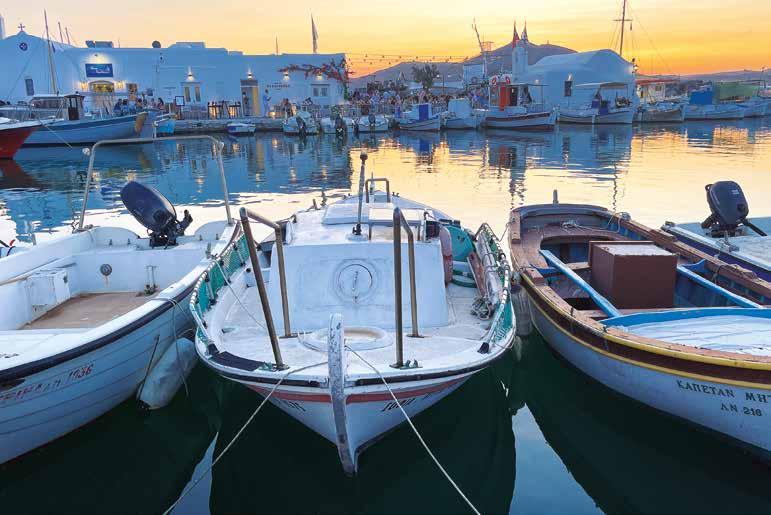
H The welcoming little port of Naoussa.






H Panoramic view of the Golden Beach.

out the beloved beaches of the north, such as the emblematic Kolymbithres, with their granite rocks, and Ampelas, with its cool turquoise waters. Instead, we decided to spend a really peaceful day (something which will probably change as we reach the height of summer) at a place known as... Palm Beach. This is no coincidence: in Agia Irini, the palm trees take centre stage. The beach is named after the whitewashed chapel of the same name that stands at the edge of the bay. If we look upwards, we can see another chapel: the whitewashed Agios Giorgis, emerging from the green, bushy vegetation on the hill.
We enjoy a simple summer lunch at the small tavern and then we’re ready for an afternoon of pocket-sized summer magic. We leave the car and take the ferry from Pounta. In just a few minutes, we arrive in Antiparos, the carefree “sibling” of Paros. We stroll along the central paved alleyway of Chora, passing bars, tavernas and gourmet restaurants nestled amongst white houses adorned with bougainvillea. After enjoying a refreshing drink and some grilled fish, we head to the tiny fortified settlement of Kastro, which is located just beyond the tasteful shops. It is interesting to see how these island settlements were constructed during the Venetian occupation, designed to protect the inhabitants from enemy raids.
Η
Day 5 Our wanderings in the south-eastern part of the island brings us to the beach with the unusual name of Lolantonis. After crossing the dirt road lined with Cycladic villas, we reach a sandy beach with crystal-clear waters and tamarisk trees providing muchneeded shade. The natural landscape appears to be untouched and the scenery is idyllic.
Later, we visit the picturesque village of Drios, where we enjoy the star of Parian delicacies, the “gouna”, in the harbour surrounded by boats and fishing boats. It is mackerel that has been cooked for hours in the hot sun before being grilled. Spicy and juicy, drizzled with lemon oil and parsley, they are the perfect accompaniment to the icy souma, Paros’s signature drink. We watch the turquoise waters lap against the beach and see a woman fishing alone on the rocks. These rocks were used in ancient times to haul ships ashore.
H The traditional “gouna” fish dish.

We return to Parikia just as the sun is setting. Many people crowd onto the rocks at the edge of the city, near the windmill-bar, to watch the sun sink like a ball of fire into the sea. The ultimate experience is enjoying a cocktail at one of the bars overlooking the quay. The beach in front of us has turned velvety purple, while children play happily in the sand. There could be no better way to end our journey. Perhaps just a sweet treat for the senses: a bite of baklava with walnuts, almonds and powdered sugar, to make the experience of the enchanting Cycladic island even more enjoyable.
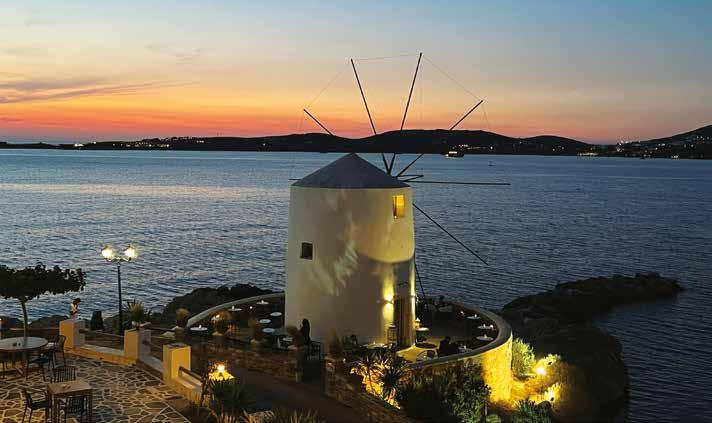
H An impressive sunset from the windmill-bar at the edge of Parikia.
Μάρκος Παπαδοκωνσταντάκης

“Roles are a journey of self-awareness”
THE PUBLIC WAS INTRODUCED TO HIM IN THE TV SERIES “WILD BEES” AND LOVED HIM IN “THE WITCH”. THE TALENTED ACTOR SHARES HIS DEEPEST THOUGHTS ON ACTING AND ITS IMPORTANCE IN HIS LIFE.
ΒY MIA KOLLIA
PHOTOS: ANDREAS SIMOPOULOS
STYLING: SOPHIA TSAKIRI
GROOMING: MORFE

IMt may have been a TV series, and specifically Alpha’s “Transparent Love”, that brought him into most homes, as they say, but Markos Papadokonstantakis has a long career as an actor, which he pursues in his own way, with calm and focus. This TV filming period is very demanding, as one week he might have three consecutive shoots in Penteli from 8pm to 5.30am, and the next week he might be working from 7.30am and as long as he needs to. But theatre is always there, in his mind and heart.
How did you decide to become an actor?
It might sound strange, but it’s because my parents are very religious and we went to church when I was a kid. The church service has a lot in common with the theatrical ritual and I think that’s what led me there. There is also a belief in something beyond in theatre too -sometimes it is a higher power that puts you on stage.
What is your relationship with religion?
My relationship with religion is more of an intimate matter for me. I am not the kind of person who goes to church regularly. For me, religion is the belief in something higher. It’s not something I personify either -I could call it theatre, a love story, the birth of a child, I could call it nature... It means that you always have to bow to something higher than yourself. I think in our work, too, a writer’s text or a beautiful theatrical moment is bowing to something higher.
As I go to the theatre all the time, I have the feeling that it explains things to me that in life I might not accept at first glance. Does this apply to the actors as well?
Of course it does. Kostas Kazakos once told me that theatre is a process that makes you a better person. If not, you’d better give it up. In the sense that theatre is love. That’s why I make the connection with religion. At home, with my parents, I experienced the religion that talked about love, relationships and the evolution of one’s self. It was not a religion subordinated to the will of some texts. Theatre is the same. It’s a job that affects your neurology, your body, it requires many sacrifices. It also has a very strong element of surprise.

When you say “neurology”, what do you mean?
I’m not going to talk scientifically because I do not have this knowledge. What I know and feel in theatre is that we are asked to raise the temperature of our bodies and brains in a very short amount of time. That’s why decom-
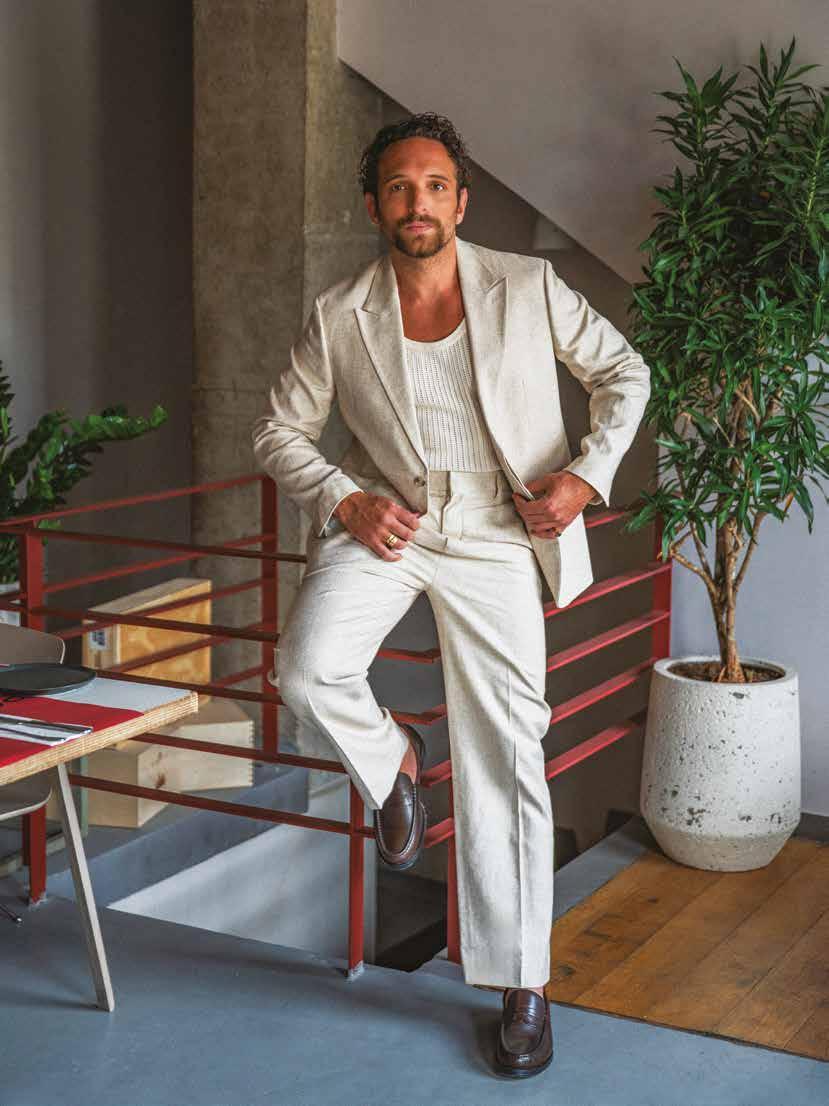


Hpressing at the end of a performance is not the easiest thing to do. Neurology in our profession is one of the key elements -you play with your mind and the labyrinths your role can reach. The character you play is not an ordinary person. They are always a person in a critical moment and on a kind of surge. You never see them in peace -that’s why you write a role. Also, a role is a journey of self-awareness. It may contain elements that you didn’t expect to share with it. So you bring them out and purify them or understand them through the role. That is, it makes you go through a process of explaining things you didn’t know about yourself.
It seems that you grew up in a very loving family... Yes, this is the case, and it is indeed a family that led me to this profession. There is a funny story: on the first day of drama school, Filareti Komninou asked us how we got into this profession. Unfortunately, 80% of the students said that their parents did not really agree with this choice. I was actually surprised at how much pressure these people were under to do what they wanted to do in the end. When she asked me, I replied that my mother told me “Either you become an actor or leave this house”! My parents were not related to the profession -my father was a manager at the Post Office and my mother worked in a photocopy shop at Solonos Street. But maybe it was some kind of repressed desire of theirs. They were people who loved reading and literature, and that is why they were involved with religion. They also loved going to the theatre.
Which are the roles that have helped you to make significant progress or have awakened something essential in you?
If I had to choose, I would mention the role of Orpheus I played with Dimitris
There is also a belief in something beyond in theatre too -sometimes it is a higher power that puts you on stage. H
Bogdanos at the Neos Kosmos Theatre, which actually got me into the Dimitris Horn Awards -although that is of little importance. I don’t know why, but this role set me on a process of starting to read philosophy and in a way to learn that roles are a study of death, perhaps because of the story I was asked to tell through this role. It brought me a step closer to understanding how ephemeral we are. I must also say that Dimitris Bogdanos is a very sensitive person and a storyteller, he likes fairy tales and I like that very much. Another role I’d like to mention is the one for which I studied method acting -an experiential approach to acting- meaning I wanted to see how close I could get to actually becoming the person I was playing. I followed some of the techniques of Stanislavski and Lorna Marshall and we did Koltès’s “Combat de nègre et de chiens” (Battle of negro and dogs). It was a production that unfortunately fell through due to the Covid-19 epidemic, but I think I came very close to the transformation -of the breath, of the body... That is, I began to feel that there was nothing of me on stage, but that something else was going on. Of course there is never complete identification with the role, there is a narration of the role, because that would not be good for the actor or the audience. The third role I think is in the project we did recently with Nikos Psarras, “True West”. I think he is a great actor and I always wanted to work with him. When I suggested we work together and he accepted, I was very happy. I know how to work a role now, but it was through this particular process that the relationship was revealed to me. I mean, this play has taught me that you can start from the relationship and get to the role and not the other way around.
When an actor’s body is under great strain, does it help or distract him?
I think this has something to do with each actor individually. It helps me a lot and I think it helps some other actors too. Like my friend Michalis Sarantis or Aris Servetalis, I guess. There are some actors who are completely physical, so they have to reach a state of fatigue with their bodies that allows them to stop thinking about meaningless things on stage and reach total concentration. Michael in “Ajax”, which he played, reached a point of fatigue where the body is identified with the spirit and you can see the whole story coming through. Because the body is a metric of the story and time in the theatre. I really like this kind of theatre.
We would like to thank Prosopa Restaurant (52 Megalou Vasileiou Street, Athens 118 54, www.prosopa.gr) for the hospitality.

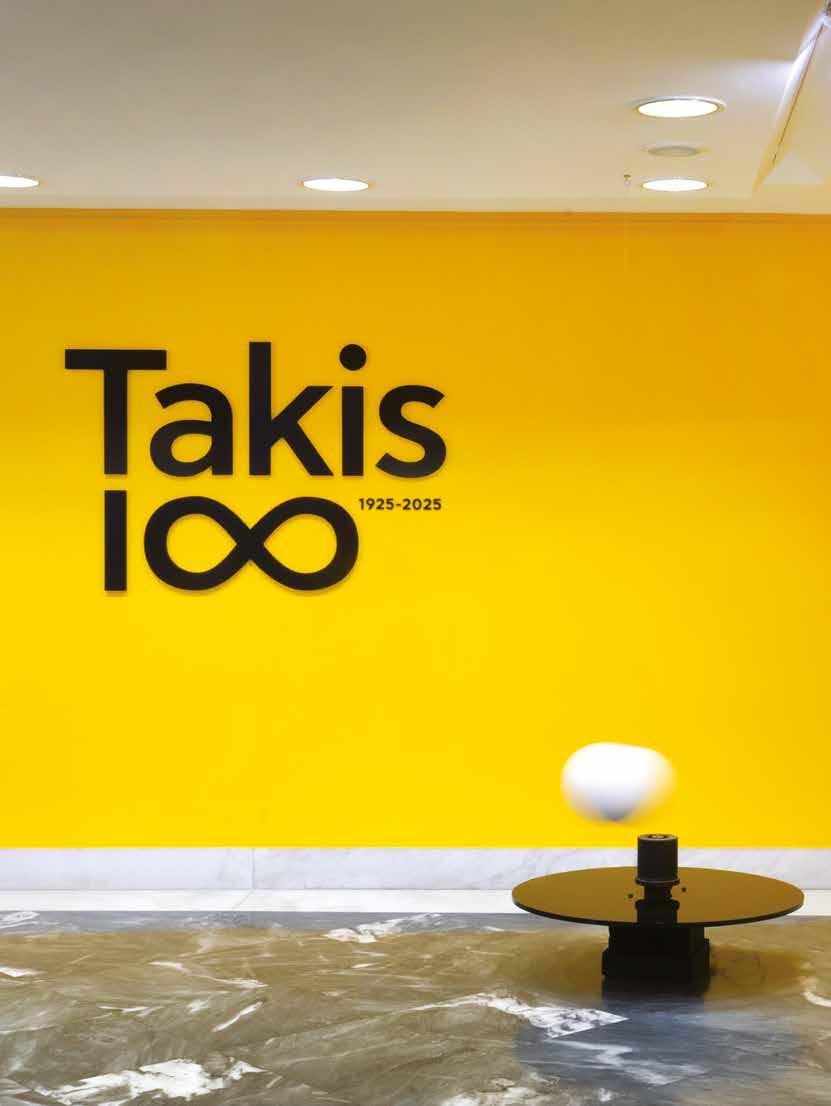
THE RETROSPECTIVE EXHIBITION “TAKIS
1∞”, SHOWCASING THE WORKS OF THE RENOWNED GREEK ARTIST WHO FUSED SCULPTURE, PAINTING, PHYSICS, AND MATHEMATICS, IS YET ANOTHER COMPELLING REASON TO VISIT THE MUSEUM OF CONTEMPORARY ART OF THE BASIL & ELISE GOULANDRIS FOUNDATION ON ANDROS THIS SUMMER.
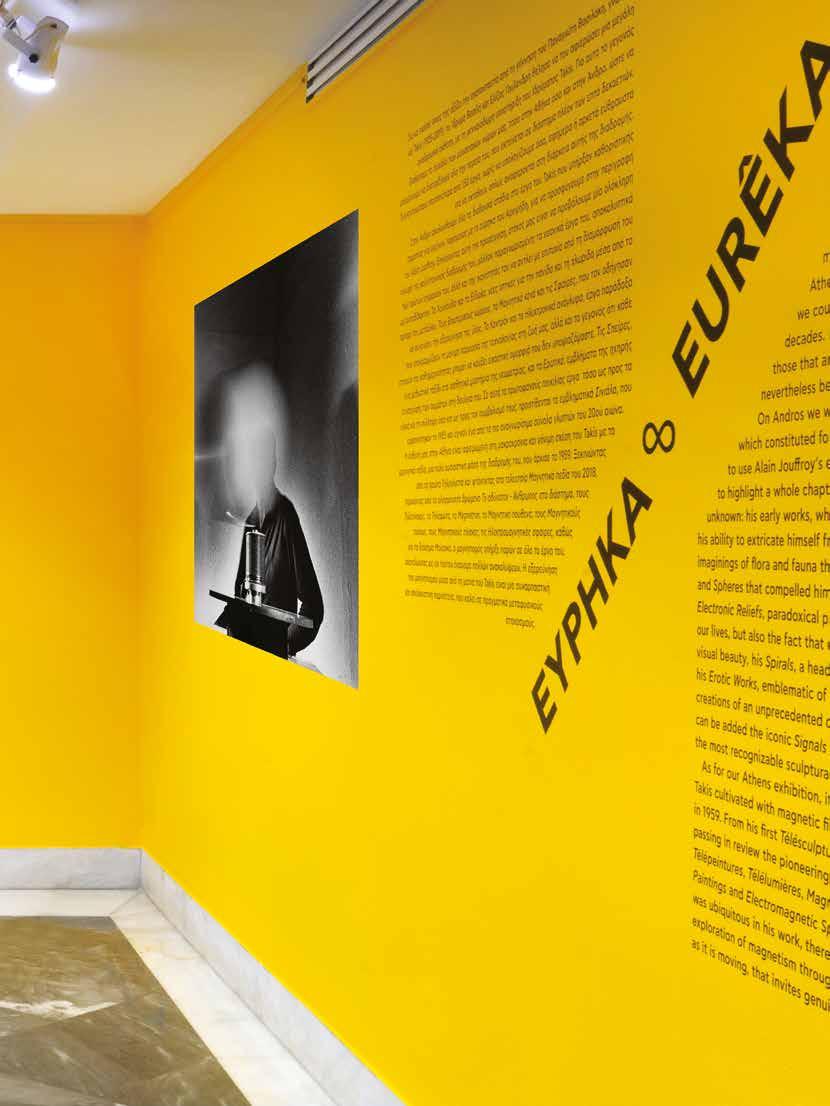

IAs tarted painting, which I struggled with, so to speak. My family told me to do sculpture. And indeed, I realised that I was going round in circles. I was generally very mobile. And it went very well for me. But because I was very inventive, I always liked trying to do things as a child... For example, I would turn water into gold” says Takis in an excerpt from Lakis Papastathis’s show, “Paraskinio”. Indeed, during his lifetime, he invented and reinvented everything the mind could conceive.
In his hands, science and the arts were an alloy. Engineering, physics, chemistry and mathematics were fused with painting and sculpture to create works of art the like of which humanity had rarely seen; only Michelangelo had combined so much together. His creations adorn the world’s greatest museums, and many of them can be enjoyed here in Greece until 2 November, courtesy of the Basil & Elise Goulandris Foundation and the Takis Foundation, commemorating the 100th anniversary of the birth of Panayiotis Vassilakis, known as Takis (1925-2019), with a major retrospective exhibition entitled “Takis 1∞”. The exhibition is presented in parallel at both Goulandris museums in Athens and Andros.
Maria Koutsomalli, the art historian, head of the museum’s collections and curator of the exhibition, points out that “it was important to hold a major retrospective exhibition of Takis’s work in Greece, as none has ever been held except at the School of Fine Arts in 1993, when they presented an exhibition

H Above: Takis in Anakasa with two busts from plaster.
Right page, above: “Inner Space”, 1963, “Hellenic Diaspora” Foundation Collection.

that had previously been held at Jeu de Pomme. It was also a way to honour Basil and Elise Goulandris, who were among Takis’s earliest supporters. They were his friends and bought several of his works. Now that we have prepared the exhibition and reviewed our archives, we have found some beautiful photos of Takis visiting Andros with Basil, who showed him around his hometown. We also found a letter from Elise in 1990, in which she asked Takis for advice on what should be included in the museum. There is also furniture and artwork that was made specially for Basil, which shows that their relationship was more than just that of collector and artist”.
The tribute, “Takis 1∞”, showcases Takis’s artistic career spanning almost seven decades and comprising over 150 sculptures, drawings, paintings and pieces of jewellery. It is accompanied by cinematic references to his ephemeral works and creations.
As a true cosmopolitan, Takis used art to express concerns that transcend the mere aesthetic dimension, and he embraced each new chapter in his artistic journey with enthusiasm. This exhibition gives us the opportunity to reposition Greece at the heart of artistic creation through the work of a complex, unruly and demanding, yet irresistible, artist.
The Museum of Contemporary Art in Andros showcases the various stages of Takis’s career, highlighting the significant events that shaped his work. Thus, this exhibition presents a rather overlooked but complete side of his artistic journey: his early works, which reveal both his influences and his ability to break free from his self-taught training and excel. The “Flowers” and “Idols”, which were new perspectives on fauna and flora through the prism of metal.

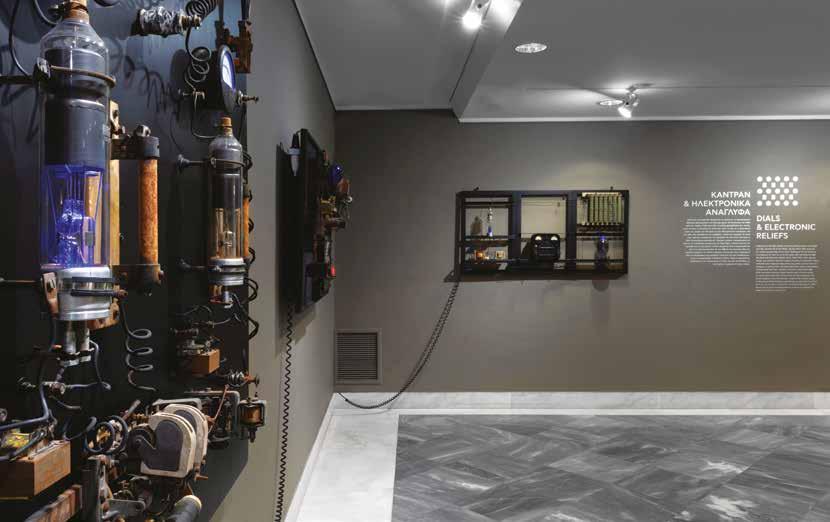
2.
H Right page: 1. “Magnetic Void”, 2016, Takis Foundation Collection.
2. “Purple Dial (The Purple Subway Drive)”, 1969, “Hellenic Diaspora” Foundation Collection.
The “Interior spaces”, “Magnetic voids” and “Spheres”, which led him to continue exploring matter. The “Dials” and “Electronic Reliefs» are paradoxical works that highlight the permanent presence of technology in our lives and the artistic beauty hidden in everyday elements. The “Spirals”, an intoxicating journey into the aesthetic mysteries of geometry, and finally the “Erotics”, emblematic of the resounding return of the body to his work. These works of unprecedented variety in terms of both materials and conception, as well as symbolism, are complemented by the iconic «Signals», which emerged in 1955 and became one of the most recognisable sculpture sets of the 20th century.
To mark the anniversary tribute, the Foundation is launching its first series of podcasts, entitled “B&E Goulandris Podcasts: An Audio Dive into the Enchanting World of Art”. The first section of the series comprises five episodes detailing the turbulent life of Takis: from his youth in occupied Greece and his artistic journey, which took him to Paris, London and New York, to his return to Athens and the establishment of the eponymous foundation and research centre on the hill of Gerovouno.
Listeners can dive into Takis’s explosive universe and observe his works in a new light through rare sound documents, enlightening discussions with the exhibition curators and anecdotal stories from people close to him. The podcasts are available on all platforms (Spotify, Apple Podcasts, YouTube Music, etc.), on goulandris.gr and via QR codes in the exhibition areas of the Foundation’s temporary exhibitions.
The exhibition is accompanied by an extensive catalogue, available in both Greek and English. Public guided tours are planned in Greek and English. Group and private tours are also available upon request. Creative workshops for children aged 5-7 and 8-12 will be held at the Museum of Contemporary Art in Andros until 31 August.
goulandris.gr
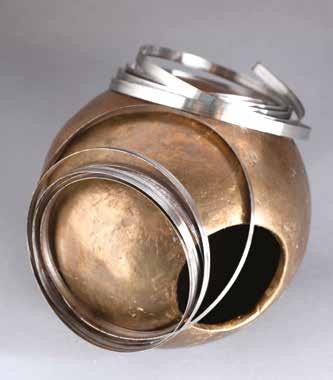

January. He arrives in Paris. He stays in the neighbourhood of Convention. For a few months he joins the Brâncuși atelier. He creates plaster statues with the intention to exhibit them at his friend Rhea’s gallery. The statues are not exhibited. London’s Hannover Gallery holds a group exhibition in which Takis’s works are presented for the first time.
He visits the United States for the first time. There, he meets Greta Garbo and Marcel Duchamp through a Greek writer and poet, Nicolas Calas. Alexander Iolas organizes in his New York gallery an exhibition entitled “Sculptures Télémagnétiques” (Telemagnetic Sculptures), which is based on a musical poem by Brion Gysin. Iolas will be Takis’s sole trader and spokesman up until 1976.
1964
He lives permanently in London, specifically in an atelier at the area of Chelsea. He meets John Lennon, Yoko Ono and Paul McCartney.
October: Alexandre Iolas Gallery in Paris arranges an exhibition for Takis, entitled “Dix Ans de Sculpture” (Ten Years of Sculpture). He purchases the land on Gerovouno Hill and constructions begin on the Research Centre for the Art and the Sciences (K.E.T.E) which for several years will be his home in Greece.
November. The Centre Georges-Pompidou hosts an exhibition at the

1986
Foundation Research Center
Forum based on Takis’s “3 Totems - Espace Musical”, with the same title. It is one of the most monumental works of the artist.
November. He founds the Research Centre for the Art and the Sciences.
The French Government and more specifically the municipal authorities of Paris grant Takis the use of the largest public space that has been ever given to any artist in the history of Paris. He creates the “Foret Lumineuse” (Luminous Forest), which consisted of 39 Signaux Lumineux-Vis d’Archimède (Luminous Signals-Archimedes Screw), at a height of 3.5m up to 9.5m, which he showcases in the Esplanade de La Défense.
The Galerie Nationale du Jeu de Paume hosts a retrospective exposition of Takis. So far, this is the largest and most important exposition dedicated to the artist. The French Republic honours Takis with the special edition of a stamp depicting his Spiral.
February. The Palais de Tokyo, in collaboration with Alfred Pacquement, has a retrospective entitled “Takis. Champs Magnetiques” (Takis.

Esplanade - Bassin της Défense. 1993
Champs Magnétiques (Τάκις.
Magnetic Fields). Around fifty remarkable pieces from throughout his entire career are presented. It is one of the most complete individual exhibitions paying tribute to Takis’s work.
Tate Modern organises the largest exhibition of Takis’s work ever held in the UK. The exhibition, organised by Tate Modern in collaboration with MACBA Museu d’Art Contemporani de Barcelona and the Museum of Cycladic Art, curated by Michael Wellen, is presented on the third floor of the iconic building, where 70 representative works from throughout the artist’s career can be viewed and appreciated.
November. White Cube presents in Hong Kong the first solo exhibition of the artist in Asia. It features sculptures from 1960-1990, showcasing the artist’s committed exploration of art and science.

O Takis
in London, 1955.


The scenery of Andros is a green carpet: running waters, lakes and waterfalls, high mountains and gullies, caves and rock formations, an impressive coastline and attractive beaches, but also imposing tower houses, arched bridges and traditional water mills -all this compose a dreamlike landscape that stands out from the other Cycladic islands.
If you are looking for the peace and tranquillity that nature has to offer, and if you love hiking, then Andros is definitely your (Cycladic) paradise. There are more than 25 certified routes covering tens of kilometres, passing through beautiful, picturesque villages with distinctive architecture, stone-built bridg-
FAR FROM THE IMPRESSION WE HAVE OF THE CYCLADIC ISLANDS, ANDROS, FULL OF LUSH VEGETATION AND SPRINGS, EXCITES LOVERS OF NATURE AND ADVENTURE, BUT ALSO OF MARITIME HISTORY.
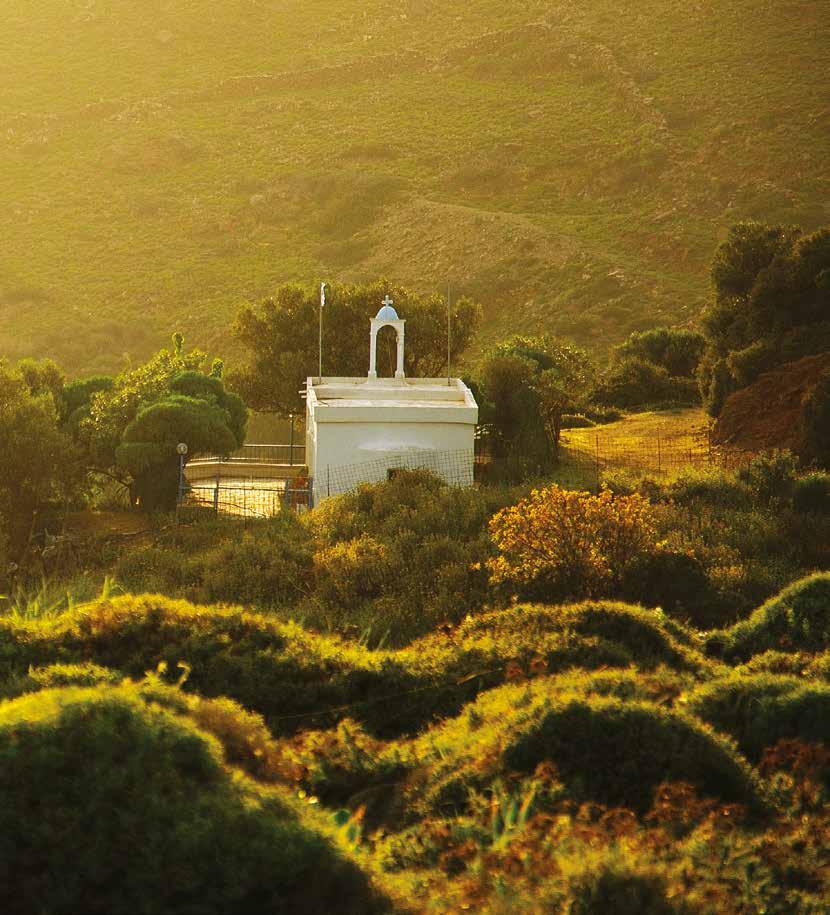
es and traditional water mills, historic monasteries and modest chapels. There are also stunning waterfalls, such as those of Pythara, where legend has it that fairies used to bathe in its waters. Not strange at all, as the landscape looks like something out of a fairy tale. You will be amazed by the beauty of nature -lush forests, shadowy plane trees and playful ponds that are home to all the creatures of creation. If you later head towards the Apikia settlement, you can quench your thirst at the stone fountain with its thermal water. This is also where the Sariza water bottling plant is located. The rural landscape you will cross on the hiking route to the wetland and beach at Achla is also of unique beauty. En route, you will also come across the walled, castle-like monastery of Agios Nikolaos. Founded in 1540, it is renowned for its bell towers, arches, priceless religious artefacts and holy relics. Now, if you follow the path from

Agia Ekaterini to Gialos of Korthi, you will find yourself diving into the turquoise waters where the legendary rock emerges at the secluded beach of Old Lady’s Leap, “Tis Grias to Pidima”, which boasts wild and otherworldly beauty. Continue your wanderings to the lush, green village of Menites (also known as Manites), whose name is probably derived from the Maenads -the nymphs who followed the god Dionysus. Quench your thirst with the crystal-clear water that was considered sacred in ancient times, which still flows abundantly from the marble lions’ mouths at the springs today. Also worth a visit is the area of Korthi in the south of the island, where you can admire some ornate dovecotes that have been declared listed monuments and are harmoniously integrated into the natural landscape. Explore the small village of Episkopeio with its dark, stone-built houses and narrow, labyrinthine alleys. Walk among pine, olive, cypress, and fig trees until you reach the stone bridge known as the bridge of love from the film “Little England”, directed by Pantelis Voulgaris. The birdsong, chirping water, and rustling green leaves are the definition of absolute serenity. The other village of Korthi, Aidonia, is also dreamlike -with the “melody of nature” where lush vegetation flourishes year-round thanks to abundant running water. That is why, in ancient times, Andros was also called Ydrousa [the one with running waters]. The walk along the ravine, following the path to the elaborately decorated fountain where the “Potamos” (the name of the spring which means “river”) flows is enchanting -this is where the impressive basin is located, where the women of the village used to wash their clothes and where the inhabitants used to meet to exchange news. As you ascend the path from Kochilos village to Castle of Faneromeni, also
The island’s landscape, full of wild beauty and natural geological wonders.
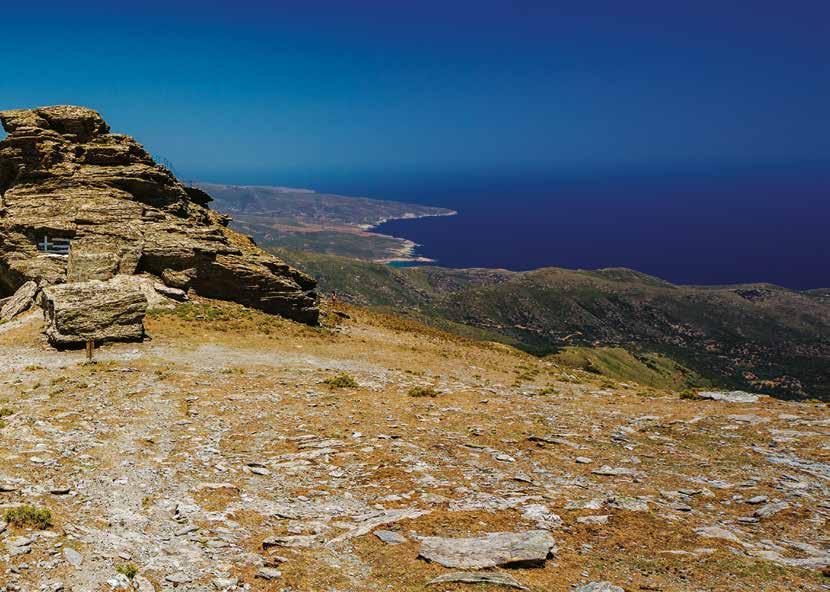
known as Epano Kastro or Paleokastro, you will have the opportunity to admire the breathtaking view of the endless blue. A visit to the Venetian castle with the remains of the houses, the underground reservoirs and the church of Faneromeni, is a real journey back in time, when the islanders found shelter here from the pirates who used to ravage the Aegean Sea. If you’ve had your fill of hiking or simply wish to enjoy the romantic atmosphere of nature, be sure not to miss the opportunity to admire the captivating sunset at Chalkolimionas, one of the most popular beaches. However, if you want to avoid the crowds, head to the beaches of Fellos and Pisolimnionas, especially the latter, in the north-west of the island. The sunsets there are simply magical. Swimming in the cool, crystal-clear waters of this endless beach is like swimming into the sunset, a true celebration of nature.
Can you imagine climbing up steep, vertical cliffs next to a roaring waterfall?
If you love mountaineering, don’t miss this opportunity: climb the limestone cliffs of Vouni with the help of experienced local guides or try the Via Ferrata in Paleopolis. Then again, if you want to cross a very beautiful gorge, head to Dipotamata in Korthi and follow the certified route of approximately 7 km.
The untouched nature of the valley, which provides a valuable refuge for the island’s rich biodiversity, the preserved traditional watermills and the stone bridge all come together to create a fairytale landscape.
But there is also a secret oasis that feels like something from a fairy tale. To find it, take the steep route to Gerolimni, where you will find an impressive waterfall on the River Achlas. The area is beautiful, with running water, ponds, bridges
H The legendary Old Lady’s Leap beach “Tis Grias to Pidima”. Below: The impressive waterfalls of Pythara create a dreamlike landscape.
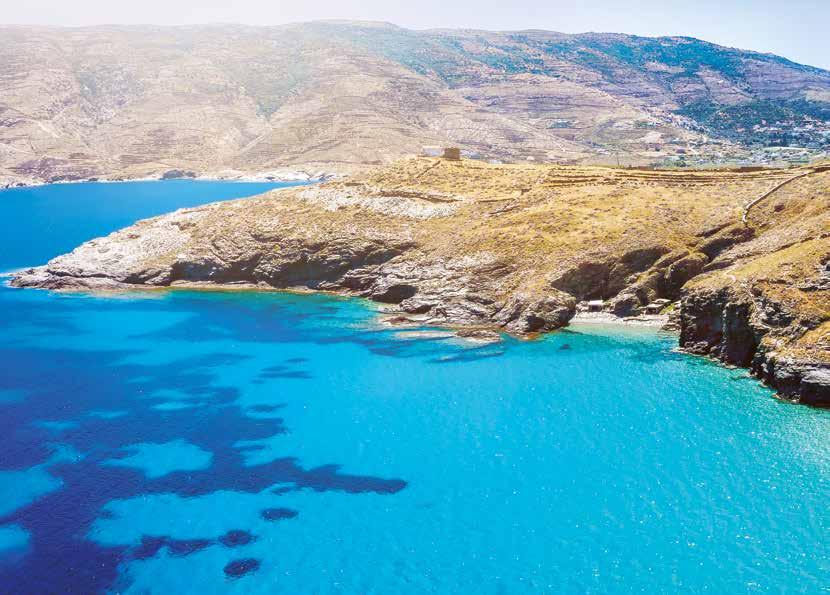
and lush greenery all year round. This is why it is protected by the Natura 2000 network. During the summer months, the experience of diving in the crystal clear waters of the lake is unique. However, the route requires special attention, as well as experience, good physical condition and suitable equipment. If you’re looking for an adventurous way to enjoy the sea, opt for diving or snorkeling. Head to the inaccessible Pyrgos Beach, the picturesque creek of Apothikes Beach, or the pebbled beach of Syneti with its underwater caves. If you’re looking to surf, windsurf or try other water sports, the beaches of Batsi, Golden Beach, Agios Petros, Kypri and Milos are ideal. If you would like to experience two of nature’s geological wonders while enjoying the last of the daylight, there are two very special options in Andros. Visit (with caution) the cave of Trypes in the north of the island, above Zorkos beach and admire the amazing view of the sea through the rocky openings. Alternatively, follow the paved path from the bridge of Aladino to reach the Foros (or Chaos) cave in Aladino, 4 km from Chora. This was one of the first caves to be discovered in Greece and can be explored on a guided tour. Admire the evocative decorations, which are rich in stalactites, stalagmites, colourful rocks and rimstone formations.
From the marble Hermes of Andros, which is exhibited alongside other significant artefacts in the Archaeological Museum of Chora, to the Goulandris Foundation’s Museum of Contemporary Art of Andros, which showcases the work of renowned artists in its collections and periodic exhibitions, not to mention the valuable rare publications housed in the Kairio Library, Andros
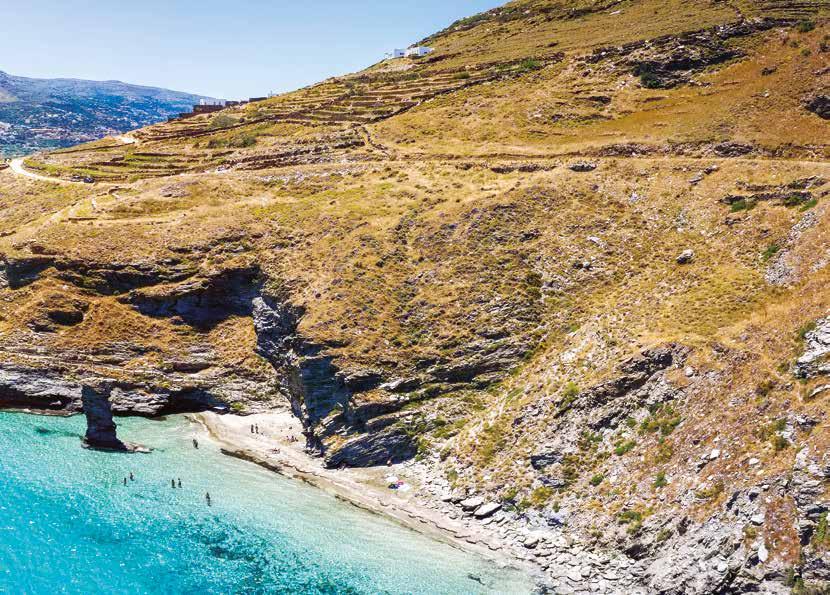
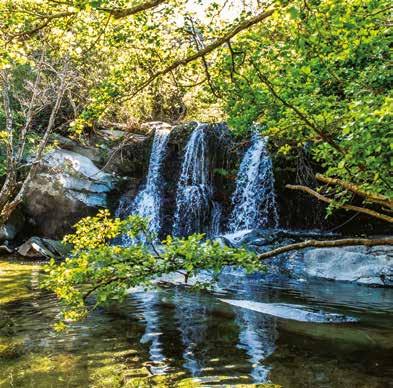

has always offered history and art enthusiasts a unique cultural experience. Known as the island of captains and shipowners, Andros is also of particular interest to those who wish to delve into the maritime history of the island and Greece in general. The ancient rock paintings in the Strophilas settlement, with their depictions of more than 100 ships, are an ideal starting point. They clearly demonstrate the region’s maritime character and the robust maritime society that began to develop from Neolithic times. And if you look at the Chora of Andros from above, it resembles a ship tearing the sea in two. As we walk along the main promenade, passing the whitewashed neoclassical captains’ houses, picturesque alleys, shady squares and well-kept churches, with the endless blue sea stretching out before us, we are captivated by this place’s timeless glamour and simple splendour. Our imagination travels through the past and present of this maritime state, which has always combined its urban and island identities in harmony. As we approach the Square of the Unknown Sailor, the island’s most famous sculpture by the Michael Tombros, we are reminded of the heavy blood toll that the island has paid over time. The Tourlitis Lighthouse is a special and unique structure, built on a rock at the entrance to the harbour and still standing proud and windswept. For over 120 years, it has illuminated the path for sailors. However, their patron saint is Panagia Thalassini (Virgin of the Sea), the jewel-like chapel built on a rock in the sea which is connected to the land and shrouded in local legend. As we pass the Kamara, the arched bridge that connects Chora to the ruined Venetian Castle on the rocky islet, we admire the grandeur of Chora -and our minds wander to the distant seas and ports where Andros’ seafarers used to sail. Once the Maritime Muse-

um’s renovation is complete, its important collection is well worth a visit. It showcases three centuries of maritime tradition through shipping contracts, insurance policies, nautical diaries, navigation instruments, nautical charts, period photographs, lithographs and models of ships from various eras. To experience the opulence of Andros’s captains’ villages, we head to Stenies, a large village surrounded by greenery, located 4 km from Chora. We walk among impressive mansions, imposing tower houses, marble fountains, galleries and flowered courtyards, as well as whitewashed alleys, churches and chapels. One of these is the Tower of Bistis-Mouvelas, which was built in 1734. It is a prime example of the 17th-19th century nobleman’s tower on the mainland, and a fine example of the architecture of today’s Andros mansions. An island that has combined nature and history in a unique way.
To discover the countless hiking routes in Andros, visit androsroutes.gr which provides all the necessary details, difficulty level, duration of the route etc. As the temperature in the summer months is particularly high and the landscape through which the routes pass is usually isolated, it is necessary to take all safety measures (e.g. water, hat, sunscreen, safe shoes) and, where appropriate, the necessary equipment (e.g. in caves, gorges, access to waterfalls and rock formations). In order to comply with all safety rules, it is advisable that hiking and climbing activities take place as part of organised activities.
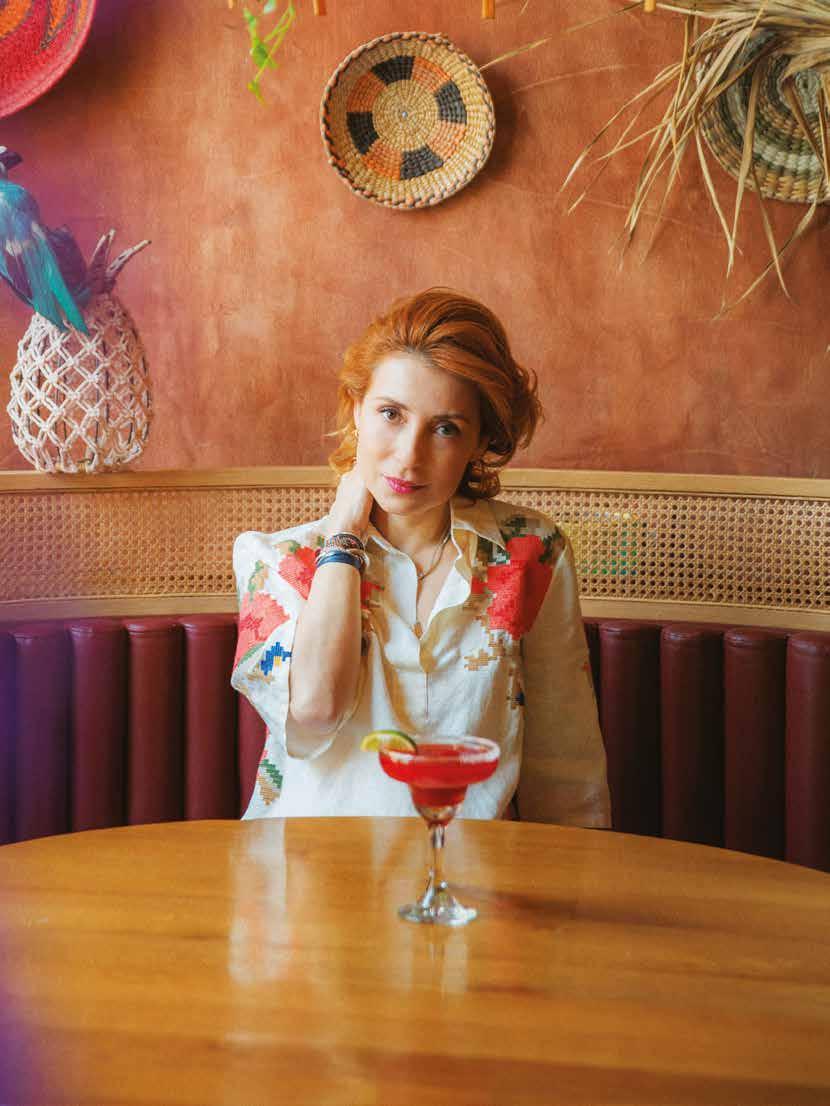
Ευδοκία Ρουμελιώτη
Evdokia Roumelioti
ACTRESS EVDOKIA ROUMELIOTI IS A WOMAN WHO CAN SUCCESSFULLY TRANSFORM HER SWEET APPEARANCE AND PERSONALITY TO SUIT EVEN THE MOST CHALLENGING AND INNOVATIVE ROLES.

She is one of the most beloved girls on Greek television and has now become a theatre protagonist who, each time, tries to do something even more challenging and unexpected.
In theatre, you can play an extreme character and do bold things, even though you are generally a quiet, sweet and timid person. How can appearance be combined with being?
For me theatre is a challenge, it is something in which I don’t want at all to play myself and whatever I carry unconsciously. We don’t do theatre for our convenience; I want to explore and find other paths. I am not interested in doing what is obvious. I want to work with people who can show me new ways of doing things that I have not thought of myself. Convenience is a fleeting thing, and ultimately, I think the essence lies in the reason why everyone does this job. I did not want to remain the little girl who played in “You Will Find Your Teacher” -a role that I do not underestimate at all and I also adore the Evdokia of that time. But if I stuck with it, it would mean choosing convenience. It would all be easy since people would recognise me. It is perfectly legitimate for someone to say “This is as far as I want to go”. But for me, that was not enough. I did not want to turn my back on this girl; I wanted to help her evolve. Maybe even to find out more about her and stop being that scared creature who was always wondering whether she was doing enough and worrying about what others would say. Fortunately, after some time, as I approached 40, I realised that I shouldn’t worry about what others thought of me, but rather do things that would make me happy.
However, I also noticed that the changes in mood and circumstances you had to cope with in Lena Kitsopoulou’s “Oresteia” last year were rapid. You don’t seem to be afraid.
I think this is related to your experiences, both positive and negative, and how they have affected you. The truth is that I did not have an easy childhood. Although my mum and stepfather loved me very much -because my parents divorced quite early on- I had emotional scars that took me several years of psychotherapy to heal. Even in moments of anger, I never forget that it is these parents who made me who I am, who inspired me to become an actor and gave me the mental strength to create and cope with such roles. In other words, I prefer being part of this family rather than another, perhaps easier, one.
This demonstrates something that is much more apparent on stage: the close relationship between weakness and strength.
Exactly! I can see it now with my own child. That is to say, when I think of a mistake I made with Dimitris, I immediately see the elements of his character that I admire, and I recognise that we have also played a part in shaping them. That is, I try to recognise the positives through my weaknesses. And I think
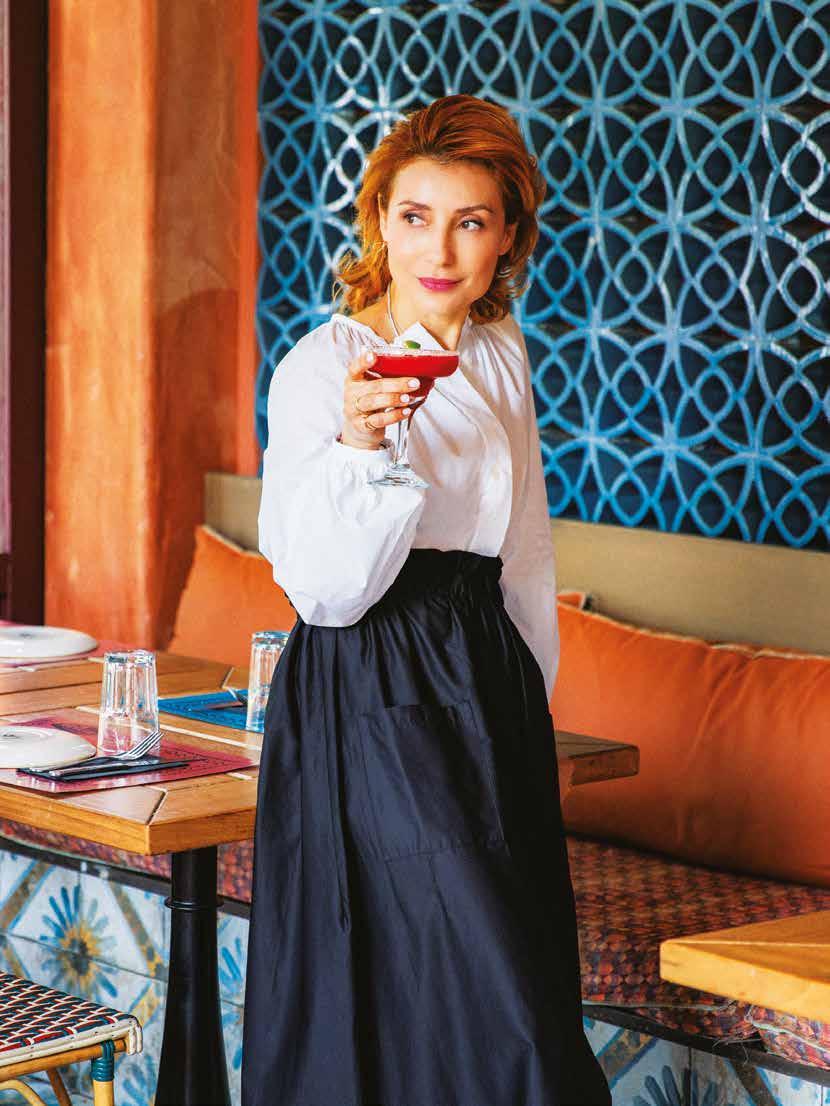
it’s great that our child is such a good kid. Because that’s all that matters in life. Kindness. You can see how important that is in relationships. I mean, if you’re kind to someone who might be aggressive towards you, they’ll probably soften their attitude towards you.
Lena is full of contradictions, too. It took everything we had to put on the show and cope with the level of difficulty she kept throwing at us, but I can tell you that once you’ve worked with her, you’ll want to work with her again and again. She opens up an incredible sense of freedom, while simultaneously “digging” into the magical truth. She is also very protective and endlessly loving. She rarely criticises, and even when she asks for something difficult, she tells you not to worry if you can’t do it, which makes you more likely to try. And you can’t disappoint her, but she’s so talented that you think she must know something to ask for it. We’ll be working together next year, but with Lena, we still don’t know what we’re going to do!
How do you really feel being in the spotlight?
To be honest, at first I didn’t feel comfortable at all. As a child, I was very shy and felt completely exposed and uncomfortable on stage. How do we

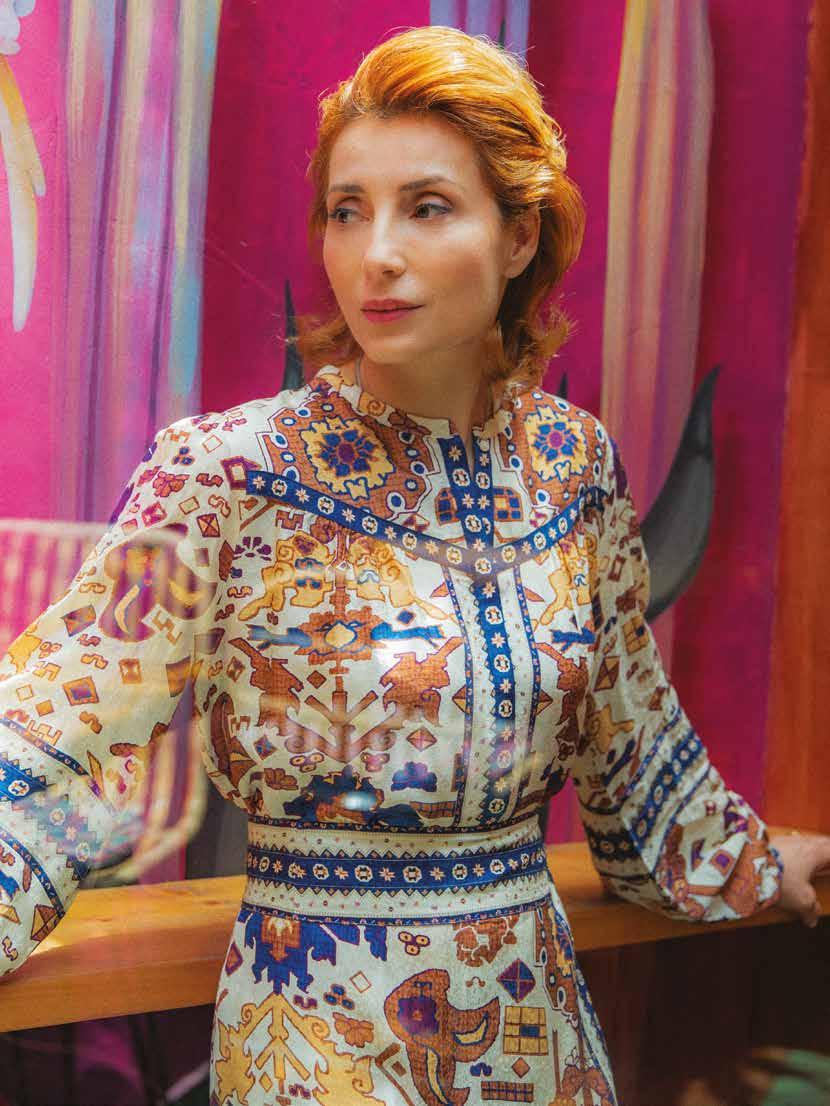
describe the feeling of someone looking at us as if they are undressing us?
That’s how I felt. I felt that those sitting below could see every detail of me, both physical and emotional. So, at first, I was completely unfamiliar with that spotlight.
I suppose that’s changed over the years.
Of course, it began to fascinate me as I grew up, for reasons other than narcissism. Narcissism is inherent in every actor; otherwise, they wouldn’t be able to endure the world of art. However, they shouldn’t just stay there. If you stay there, you are doomed to failure. You are completely exposed and this attitude becomes so widely disliked that you turn into a caricature. After all, how can you be an actor without reshaping yourself, and without, at some point while performing a role, ceasing to care about your appearance? If you don’t stop worrying about it, there’s no way you can go up there and dig deeper.
Have you ever felt that the audience was unfriendly?
It has happened to me many times. This has mainly happened in performances where people did not “expect” me to do, such as Lena Kitsopoulou’s. The same thing happened to me in Kakleas’s “Clockwork Orange”, when I performed with Aris Servetalis. I could sense the audience wondering what they had just seen.
Do you find this challenging or upsetting?
At first, my legs were cut off, in that I was thinking of how quickly we could get through our lines to be done with it. Now that I’ve finally grown up, I can handle it. Even though I’m thwarted and I’m always the kind of person who takes the blame for things, I can be persistent. I tell myself that I will stage what I loved, not exactly to get you on my side -because I may never get you on my side- but at least you will see what moved me.
On the contrary, I imagine that positive feedback gives you wings.
Okay, we’re talking about a different performance then. Having the support of the audience lifts you up. That is to say, something wonderful emerges and you build on it. This is the only way for an actor to discover amazing things. It is alongside the audience that the journey of the role begins, and it is through this that you find the thread and follow something that magically attracts you.
For example, I tried to explain to my husband when we first met how different the performance is every night, even though it seemed to him that we were doing the same thing. Television is “the same” because you know exactly what to expect, whereas theatre is a completely different experience every day! You communicate with the world in an unusual way, and you experience something that cannot be put into words.
However, the older you get, the bolder you become...
Yes! I like to take risks and I believe that, as we mature, we become less afraid, so we can take more risks and try new things, even if they are difficult, because we know how to manage them better. Also, as I grow up, I realise that I have a strong desire to work with young people and children who still have dreams and drive, and who have not yet been consumed by the system. And also, I trust them completely. I think that people who have walked this path and reached this stage in life should trust young people, stand by their side and help them as much as possible.
We would like to thank Balero restaurant (162 Char. Trikoupi Street, 145 62 Nea Erythraia, www.balero.gr) for the hospitality.
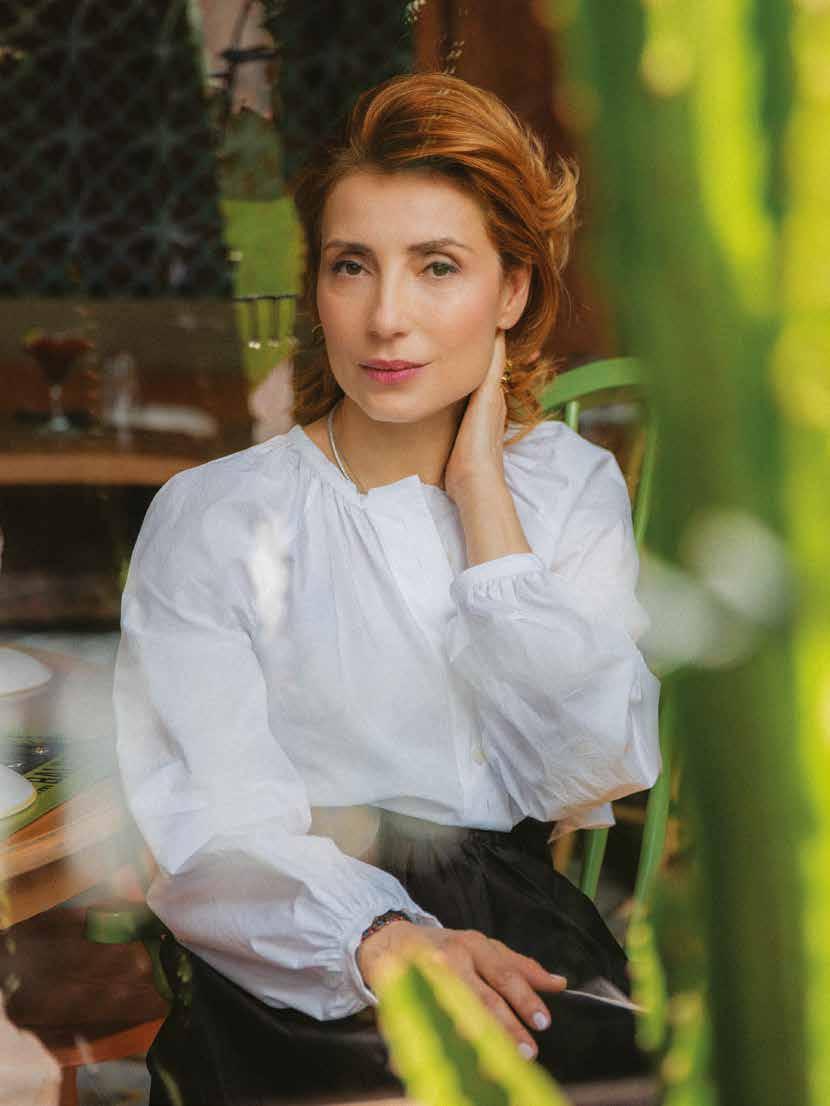



Small but mighty, the knee needs protection so that we don’t... end up on our knees. The knee joint is both extremely important and sensitive.
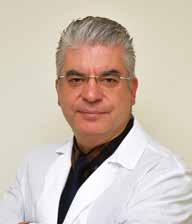
The most common cause of knee pain, particularly among people over 60, is osteoarthritis, i.e. the deterioration of the articular surfaces. In the advanced stages of the disease, when pain affects the patient even at rest (night pain), a large percentage of patients require surgery in the form of total knee arthroplasty. New advanced techniques herald the end of the era of classical surgery and large incisions, bringing minimal invasiveness -small incision and robotic surgery- to the forefront.
Minimally Invasive Knee Arthroplasty (MIKA)
This is the most modern surgical treatment method for patients with knee osteoarthritis. The operation is performed through a small incision, through which the damaged joint surfaces are removed and replaced with an artificial joint. This operation can be performed using high-tech machines, such as the Human Anatomy Navigator, or robotic systems.
Robotic knee arthroplasty is based on a three-dimensional preoperative plan while, during the operation, a robotic system assists the surgeon by providing absolute control over bone incisions and implant alignment.
The main advantages of these methods are the much smaller incision required compared to conventional surgery, minimal to no postoperative pain, less blood loss, shorter hospital stays, faster patient recovery and a much quicker return to everyday life.
Knee pain can also be caused by a torn meniscus and can affect people of any age. Arthroscopy is the solution here: an operation performed through two 5 mm incisions. Patients can leave the hospital on the same day after surgery, without the need for crutches or splints, and can return immediately to work and everyday activities.
Georgios Petsinis MD, PhD Orthopaedic Surgeon - Arthroscopist, Director of the Centre for Musculoskeletal Injuries and Health of the Female Athlete, “MITERA” Hospital, Doctor of Medicine, University of Ioannina, specialising in knee surgery, arthroscopic & robotic surgery and sports injuries. www.arthro-specialist.gr e-mail: gpetsin@gmail.com
Τι
Combined Intrarenal Surgery for complete elimination of kidney stones
When conventional treatments fail to remove large, complex kidney stones, the solution is offered by the 4th Urology Clinic, Prostate & Nephrolithiasis Laser surgery, IASO with ECIRS.
ECIRS (Endoscopic Combined Intra Renal Surgery)
•
•
•
•
• Αποτελεσματική ανεξαρτήτως
•
What is ECIRS (Endoscopic Combined Intrarenal Surgery)?
It is the Combined Intrarenal Surgery. That is, simultaneous approach to the stone by ureteroscopy and percutaneous endoscopy.
The first mini camera is inserted directly into the inside of the kidney through a five millimetre hole in the skin. At the same time, the second one approaches the kidney endoscopically by ascending the ureter. This allows us to access every part of the kidney with flexible, thin endoscopes without disturbing the delicate interior of the kidney. The use of fine tools is sufficient as the large stone load is removed from the kidney by two simultaneous routes.
Our clinic combines technology and twenty years of experience to offer every available method in a single session. This approach completely eliminates both the stone and the patient’s discomfort.
• The abundant power of the laser is exploited in every part of the stone.
• Complete elimination of lithiasis from the kidney and real relief from the problem.
• Minimum possible “battering” of the kidney.
• No bleeding and no need for transfusion.
• Reduced risk of infection.
• Effective regardless of stone size.
• Immediate recovery and return to daily life.
The world innovation of the ECIRS procedure is the complete supine position of the patient during the procedure. This patient position is the only one that supports the urologist’s comprehensive approach to upper urinary tract pathology. This modified technique eliminates the risk of thromboembolic events and joint stress. It is also the only one suitable for patients with increased body weight.

Nikos Bafaloukas Director of the 4th Urology Clinic, Prostate & Nephrolithiasis
The ECIRS technique is also applicable to paediatric urolithiasis. In cases where we have formative kidney anomalies or a strong lithogenic tendency, it is necessary to protect the children’s kidneys. The combination of thin tools and a powerful Laser minimises trauma and ensures perfect stone removal.
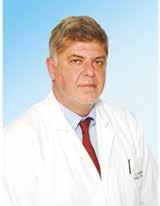
Just half a century has passed since the advent of cardiac surgery. The exponential evolution of biomedical technology has led to the development of pioneering diagnostic and therapeutic solutions for cardiovascular diseases, including minimally invasive cardiac surgery.
The term “minimally invasive cardiac surgery” refers not only to the size of the incision made during the operation, but also to other aspects. It includes preoperative screening and preparation of the patient, without hospitalisation, incorporating fitness and empowerment interventions and improvements to cardio-respiratory function, as well as a detailed study of heart problems. Similar to laparoscopic surgery, heart surgery is performed in the operating room with minimal trauma, through a small incision and without disturbing the chest cage. Using a high-resolution optical fibre thoracoscope, the procedure is carried out almost painlessly through a small hole in the chest wall. This process minimises the need for tissue preparation, reduces the requirement for blood transfusions, and increases the likelihood of the patient’s rapid mobilisation and recovery.
Aortic valve
For patients in need of an aortic valve replacement, this procedure is performed minimally invasively in our department. Valve repair is performed in patients with aortic insufficiency, with or without dilatation of the ascending aorta and/or aortic root. Replacement is performed in cases of stenosis. Mechanical valves are used for younger patients, while bioprostheses are used for older patients. Minimally invasive surgery is the preferred option for most cases of aortopathy.
Thanks to our extensive experience in this area (our department is an international training centre), we prefer the thoracic approach. It allows for serious deficiencies to be repaired using sophisticated, high-precision techniques, while also enabling rheumatic aetiology (mixed damage or stenosis) to be replaced. Endoscopic ablation has an extremely high success rate when performed on patients with atrial fibrillation. Thoracoscopic atrial appendage ligation is also performed. The operation takes a few minutes and does not require extracorporeal circulation, since no cardiac cavity is opened. It is also clearly more effective than the endovascular approach.
Endoscopic cardiac surgery is the preferred method for treating other heart conditions, such as atrial defects and heart tumours (myxoma, fibroelastoma, etc.). Minimally invasive cardiac surgery and the development of a fully endoscopic approach are offered at a few centres worldwide, including our department. This provides a new option for treating heart disease. The benefits are not only related to the excellent aesthetic results, but also to faster recovery, mobilisation and a quicker return to normal quality of life.
Konstantinos Perreas Cardiac Surgeon - Thoracic Surgeon, Director of the 1st Cardiac Surgery Department, Onassis Cardiac Surgery Center Perreas@doctors.org.uk
An ACL rupture is one of the most common and debilitating knee injuries, particularly among young, active individuals who are involved in sports. It typically follows a sprain or strain and can result in substantial knee instability, pain and reduced functionality.
As the Orthopaedic Surgeon treating Kifisia FC and Director of Sports Injuries, I know first-hand how important it is to provide appropriate, personalised care for each injury. There is no such thing as a “one-size-fits-all” approach in modern medicine. A tailored approach is required for each patient, taking into account their anatomy, lifestyle and expectations.
Modern, minimally invasive surgical reconstruction techniques offer excellent functional results for ACL reconstruction. The most modern personalised technique involves selecting and accurately placing the appropriate graft, taking into account anatomical variations, previous injuries and other needs.
However, what follows is equally important: rehabilitation.
Our team uses tools such as:
• Back in Action test: a series of dynamic measurements are taken to assess the symmetry, control and strength of the leg before allowing the athlete to return to their sports activity.
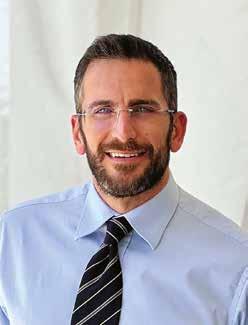
•Riablo system: an innovative rehabilitation system that uses sensors and biofeedback to accurately guide and monitor patients’ progress.
The safe return to activity is based on objective data and scientific accuracy, not “instinct”.
A ruptured cruciate ligament is not the end of the road. With the right guidance, it can provide a solid foundation for an even stronger and safer comeback.
The field of medicine has evolved. And with it comes the opportunity for a comeback that’s even better than before, with the support of our entire team!
Konstantinos S. Intzoglou, MD, MSc, PhD Director of 2nd Orthopaedic Department IASO General Clinic, Clinic of Minimally Invasive Orthopaedic Surgery, Arthroscopy and Sports Injuries MINISCO™ ORTHOPEDIC CENTER www.minisco.gr
HHaemorrhoids are one of the most common conditions affecting the anal region, with millions of people worldwide suffering from them. While conservative treatment may be sufficient in the early stages, surgical intervention is often necessary in more advanced forms.
Since 2006, I have had the opportunity to participate in the management of a large number of haemorrhoid cases alongside my teacher, Dr Georgios Grigoriadis, applying both traditional and newer techniques. Although traditional haemorrhoidectomy (Milligan-Morgan or Ferguson) -still practised in state-run facilities today- is effective, it is associated with severe postoperative pain, prolonged recovery, and an increased risk of complications.
The demand for less traumatic and more painless procedures has led to the gradual adoption of minimally invasive techniques. A milestone in my career was participating in a round table with international attendees in February 2007, under the supervision of Dr Grigoriadis. Leading surgeons such as Dr Antonio Longo and Dr Matthias Scheyer presented new techniques. The Longo method, which uses a circular stapler, repositions haemorrhoids in their natural location without removing tissue. This results in minimal post-operative pain and a fast recovery. Similarly, the HAL-RAR technique uses ultrasound guidance to locate and ligate the haemorrhoidal arteries while the mucosal lift suture corrects any prolapse.
The most innovative approach in recent years has been the use of laser. The Laser Hemorrhoidoplasty (LHP) technique uses an endovenous laser to destroy abnormal vessels in haemorrhoidal nodules without excising tissue. The procedure is almost bloodless and painless, and patients can return to their normal activities within a few days. There are no incisions or stitches, and the complication rate is extremely low. In some cases, LHP can be combined with sclerotherapy or the HeLP (Hemorrhoidal Laser Procedure) technique, which uses a laser diode to target the feeding vessels of haemorrhoids.

At our medical centre, which has over 19 years’ experience in treating haemorrhoids, laser treatment is our main option. We adapt this treatment to each patient’s needs. However, the success of an operation does not depend solely on technology. A correct diagnosis, the appropriate technique and, above all, the surgeon’s experience and judgement are all crucial for complete and safe rehabilitation. Each patient is unique and should receive the personalised care they deserve.
O•
Dr
MD, MSc, PhD, FRCS(Gla),

The thorax is the body’s natural “box” that protects the heart and lungs. Deformities such as the pectus excavatum, which is characterised by an inward dip in the sternum, or the pectus carinatum, which is characterised by an outward bulge of the sternum, can occur when chest wall growth does not progress properly.
When is Medical Intervention Required?
Parents should seek medical advice if they observe any of the following:
• Difficulty breathing during exercise
• Frequent fatigue
• Chest pain
• Problems with posture
• Psychological impact on the child
Therapeutic Approaches
Treatment depends on age, severity of condition and symptoms. Patients should be monitored by a specialist outpatient clinic (Pectus Clinic), which offers comprehensive care:
For young patients:
• Exercise and posture improvement
• Special exercises to strengthen and improve posture
• Screening for scoliosis in collaboration with a paediatric orthopaedic surgeon
• Use of special belts (back braces) for pectus carinatum
• Vacuum bell treatment for pectus excavatum
For patients over 16 years of age as well as adult patients:
• Surgical techniques such as the Nuss procedure
• Ravitch procedure
• Use silicone implants where necessary
• Minimally invasive, fully endoscopic restoration using the TERPE method. What is the TERPE Method
TERPE (Total Endoscopic Repair of PEctus) is an innovative technique that was presented in 2013 at the International Conference of Minimally Invasive Cardiothoracic Surgery in Prague (ISMCS, Prague, 2013) and was acknowledged for its originality. It was also presented at the Hellenic Society of Thoracic & Cardiovascular Surgeons’ specialised thoracic surgery seminar in 2025.
This technique is designed to be performed entirely endoscopically, using a high-definition camera and only two small incisions on the sides of the chest, without the need for metal plates. It is based on extensive clinical and basic research conducted in collaboration with recognised international institutions, the experimental laboratories of the School of Veterinary Medicine at Thessaloniki and the design and construction of new tools and techniques.
Advice for Parents
As each case is unique, it requires an individual assessment by a qualified thoracic surgeon. If you are concerned about your child, consult a specialist at a reputable medical centre with experience in treating deformities.
Dr Michael Klimatsidas MD, MSc, PhD, FRCS(Gla), Thoracic Surgeon, St. Luke’s Hospital, Thessaloniki, Henry Dunant Hospital Center, Athens www.thorax.gr
ONE WAY TO PRESERVE FERTILITY IN OLDER AGE IS TO FREEZE EGGS, I.E. TO COLLECT AND PRESERVE OOCYTES IN APPROPRIATE CONDITIONS FOR FUTURE USE.
In which cases is cryopreservation the recommended method?
• Women who wish to delay childbearing for medical, professional, personal or educational reasons.
• Women with a family history of premature menopause.
• Women who have recently been diagnosed with cancer can maintain their fertility by freezing their eggs before starting treatment.
• Women who, for religious reasons, do not want to freeze embryos.
The scientific evidence from around the world confirms that it is a completely safe method. International literature and medical studies show no link between the use of assisted reproduction medications and an increased risk of cancer.
Ideally, it should be done by the age of 35, and it would be good to do it as soon as possible. The reason for this is that every woman is born with a fixed number of eggs. Over time, the quantity and quality of this number decreases.
Before starting the procedure, some specialised blood tests and an ultrasound are performed to assess the ovarian reserves. We then proceed to ovarian stimulation, which involves one or two injections per day. The ovarian stimulation process lasts approximately 12 days. During this time, injections are combined with more intensive ultrasound and laboratory monitoring. Once the follicles have reached the appropriate size, we proceed with egg retrieval. We then assess their maturity and cryopreserve the mature ovarian follicles. The procedure is completely safe and painless.

According to the legislation in our country, Cryopreservation can last for a maximum of 20 years. After this time, women can apply for an additional five years if they wish.
When the time comes that the woman wishes to use them, the eggs are placed in a special solution and fertilised with her partner’s sperm. After three to five days, according to the plan set by your doctor, the fertilised eggs are transferred to the uterus.
Pantelis I. Trompoukis Associate Professor of Obstetrics and Gynaecology trompoukis.gynecol@hotmail.com www.trompoukis.gr


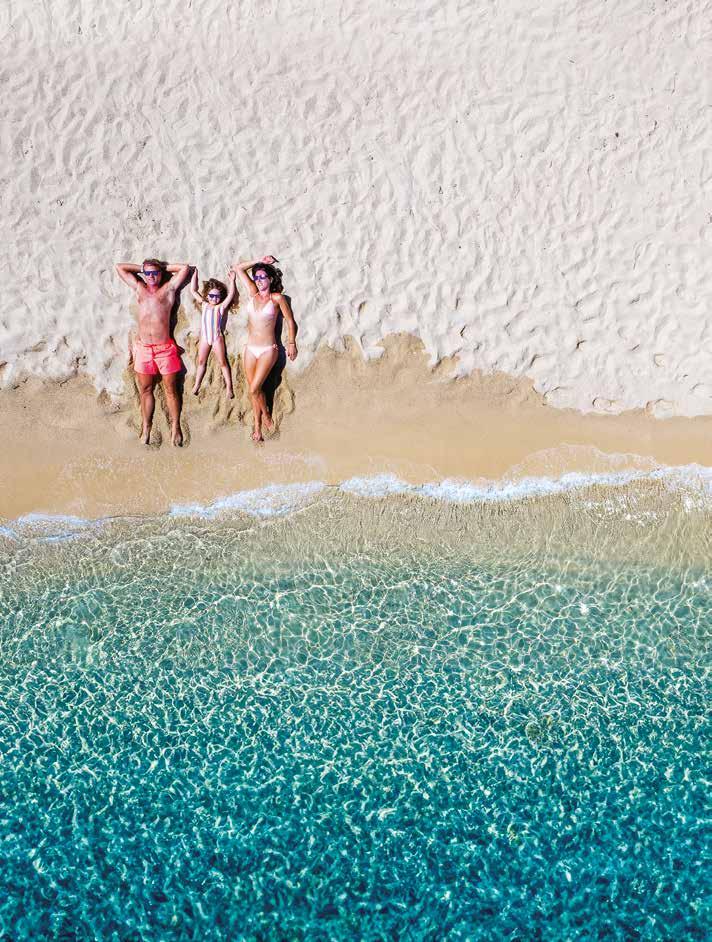
t seems unlikely that one could find such a secluded beach in August on the most popular islands of the Cyclades. And yet, thanks to the extensive coastline, there are countless beaches to enjoy. Stay away from the beaten track, discover your own beach and enjoy it with your loved ones.


